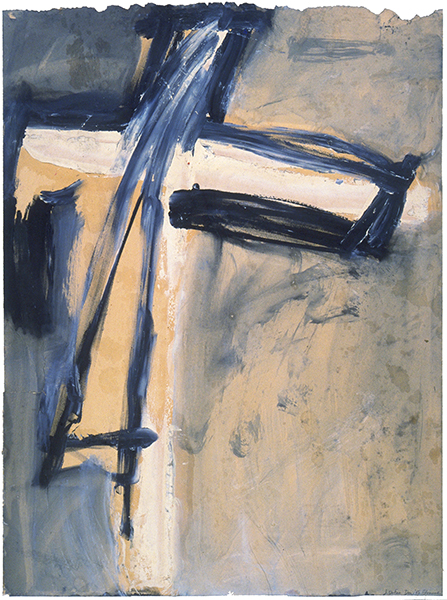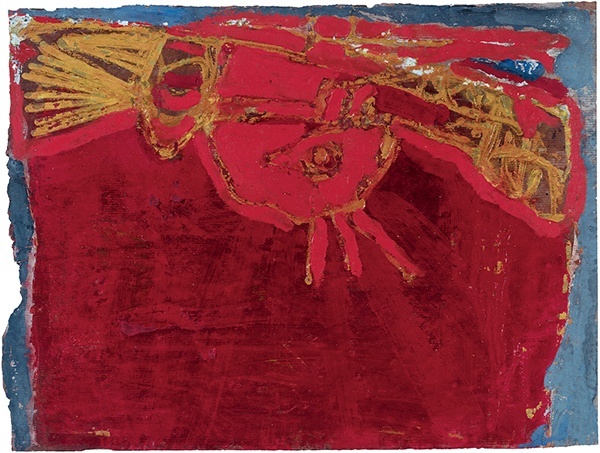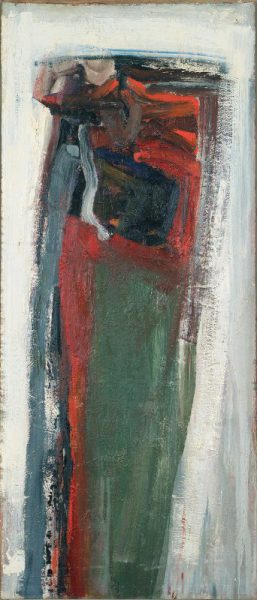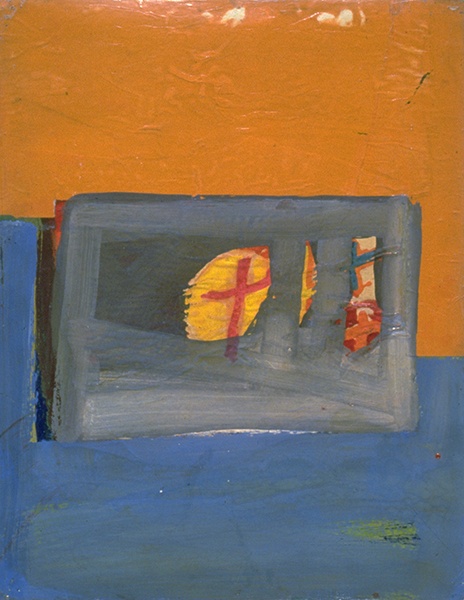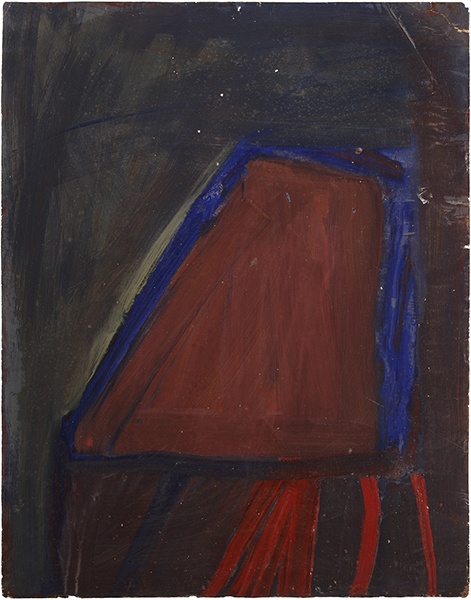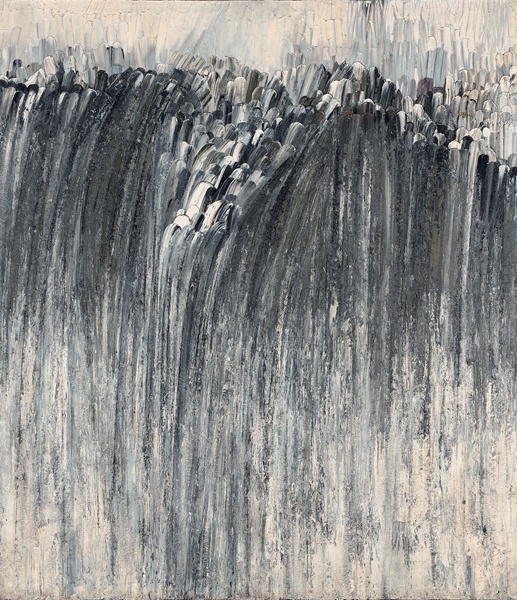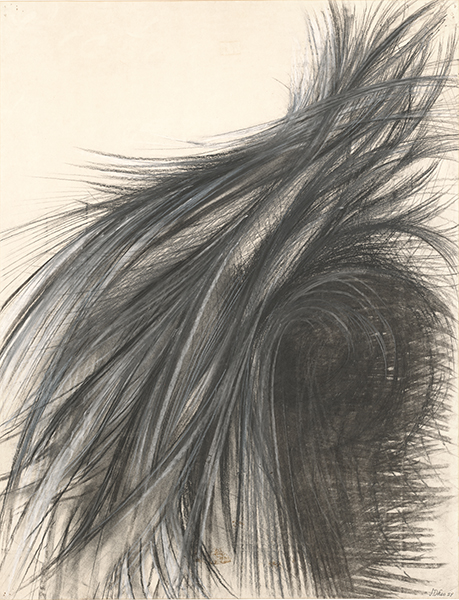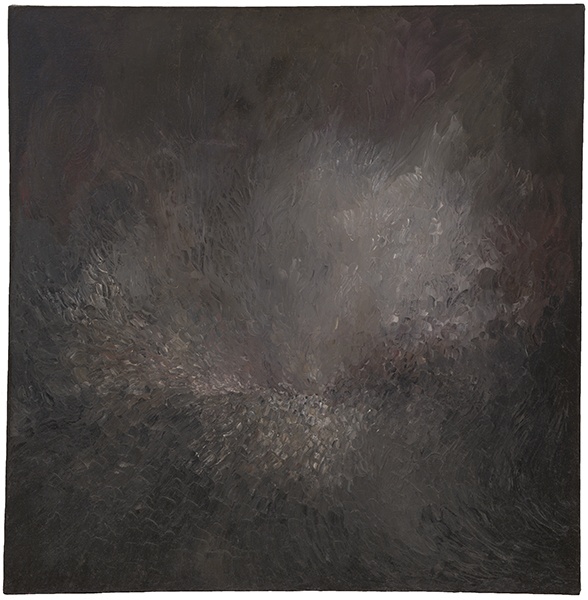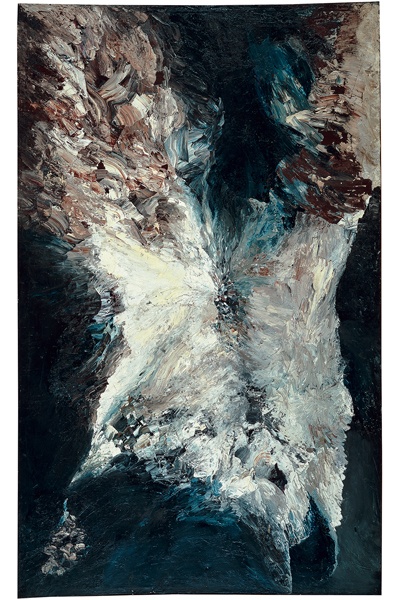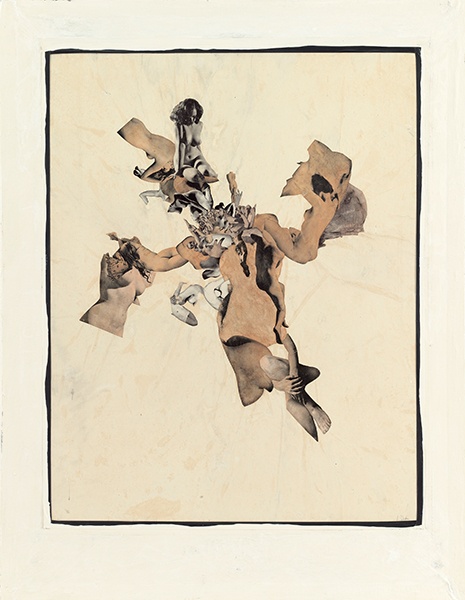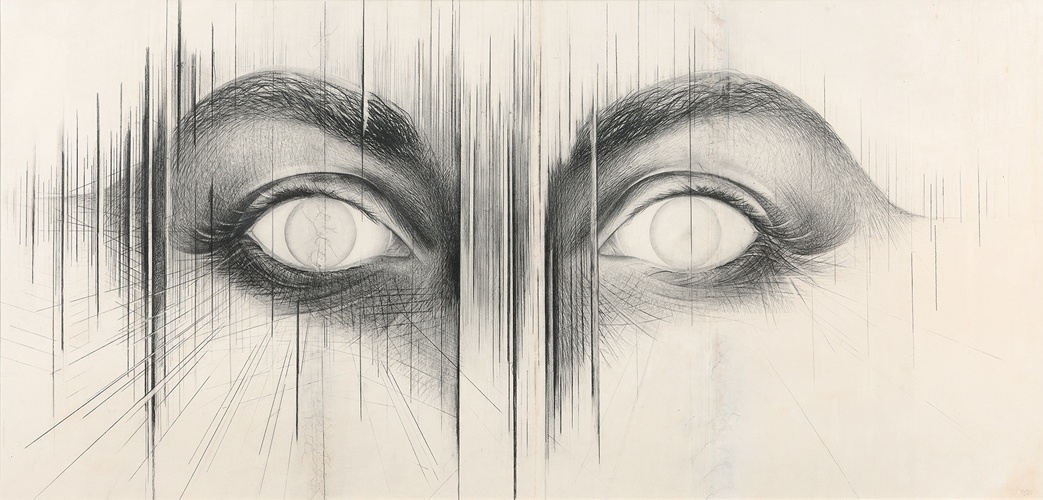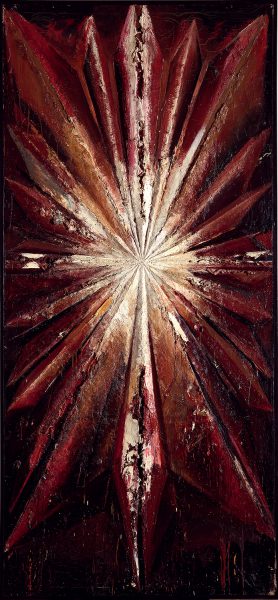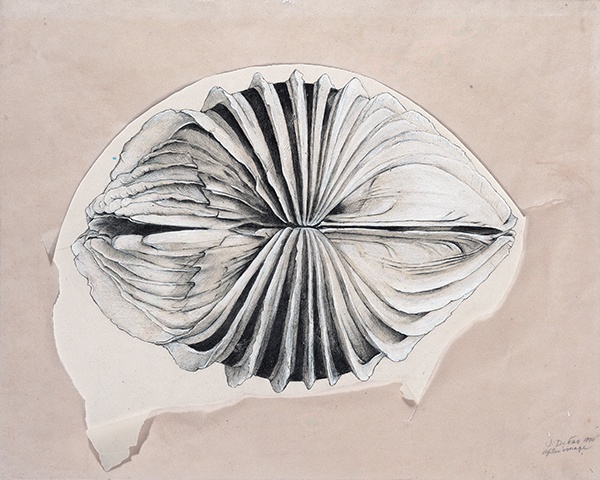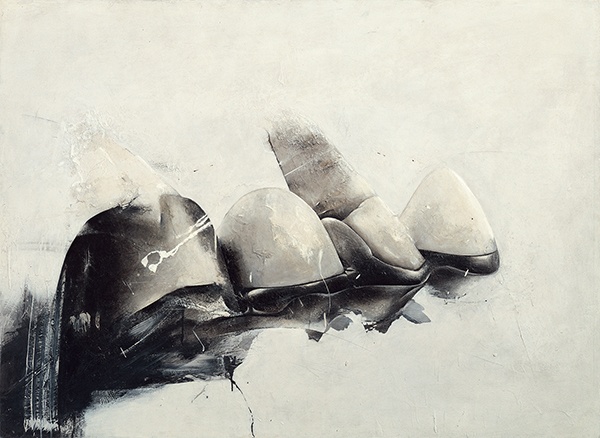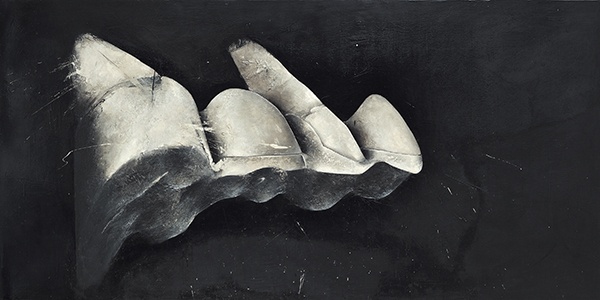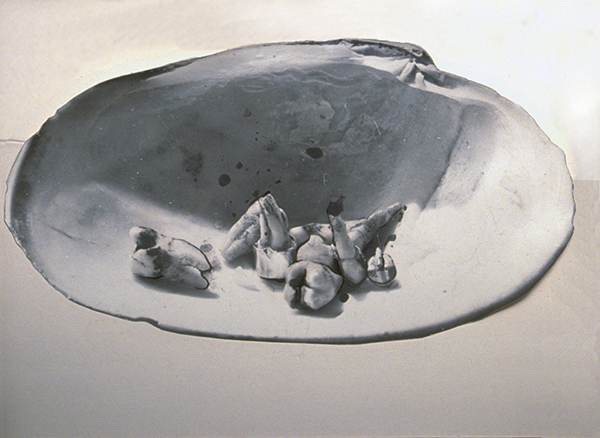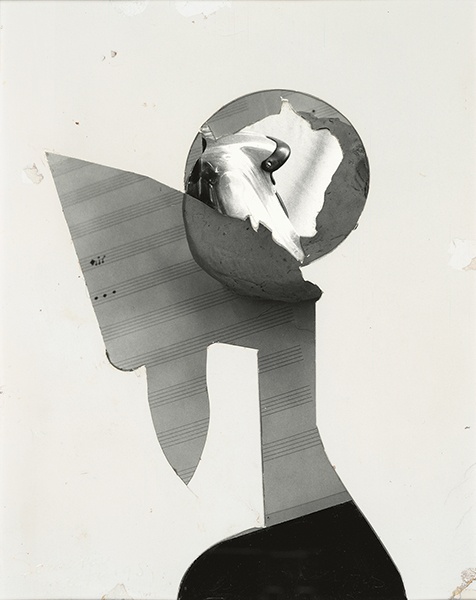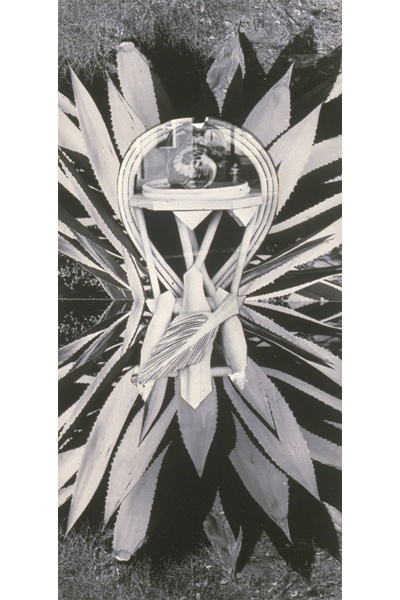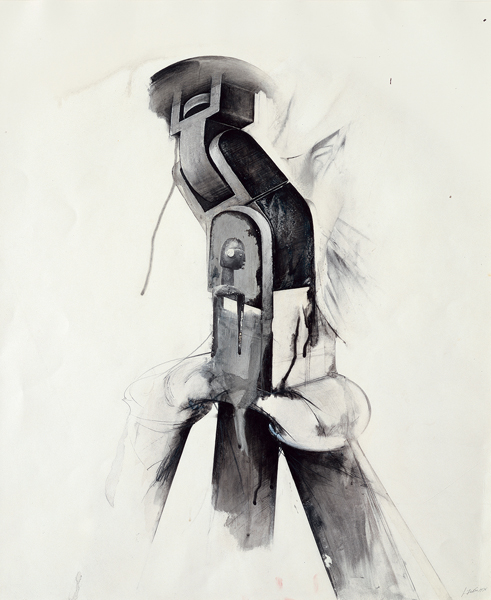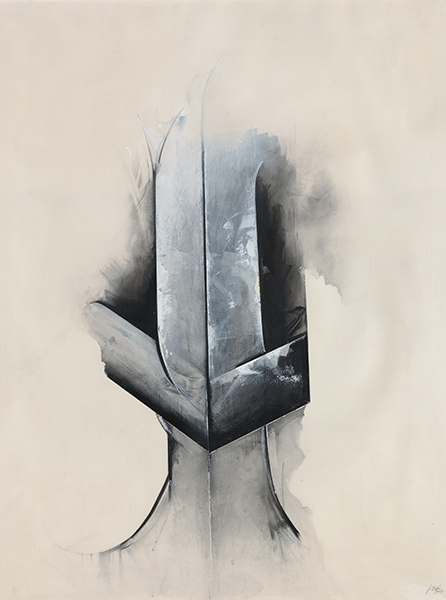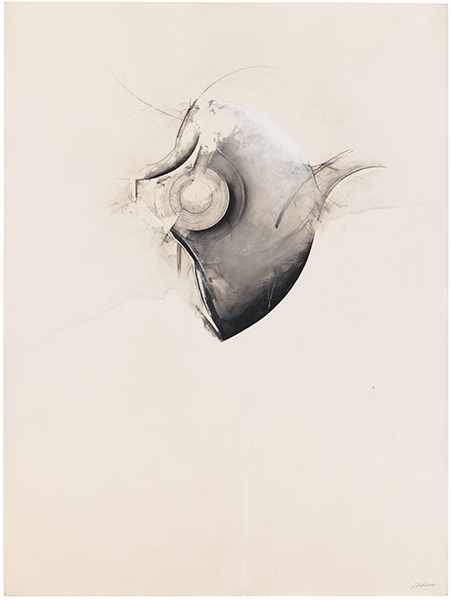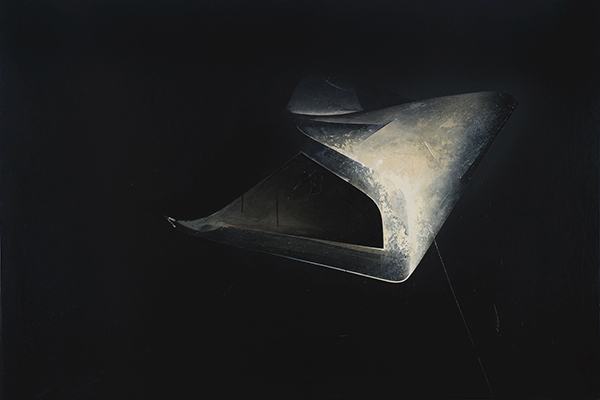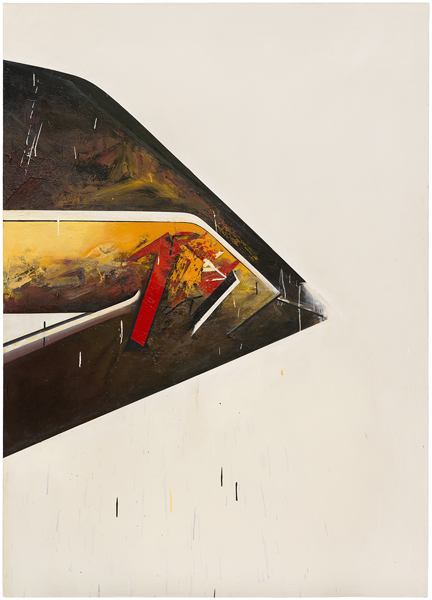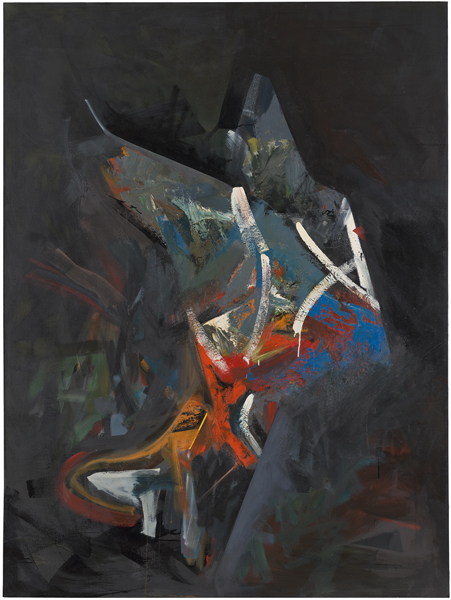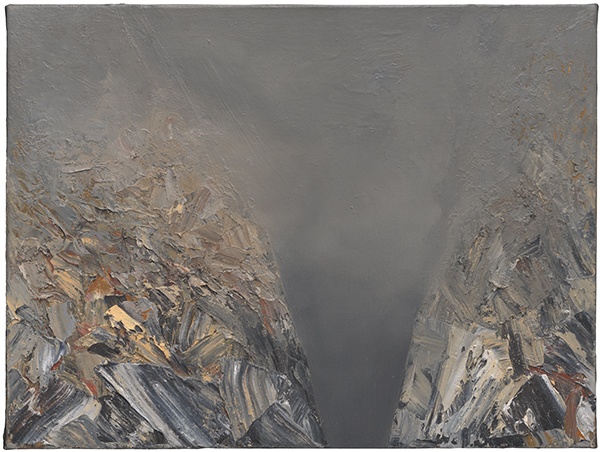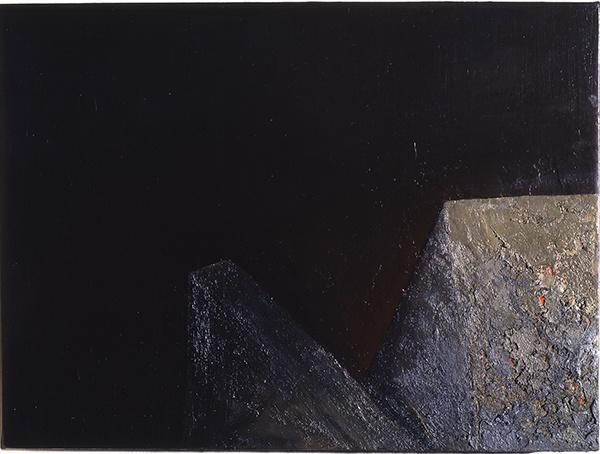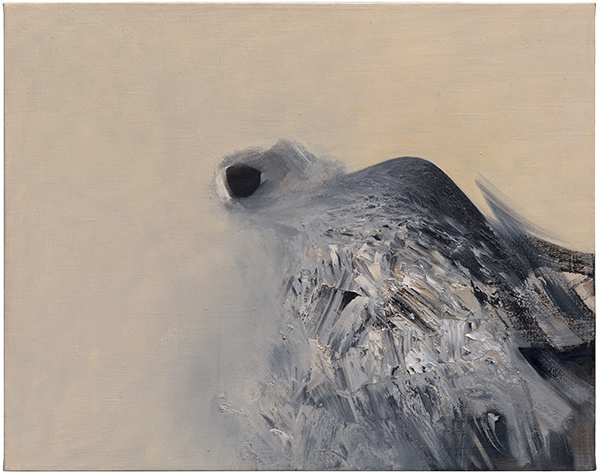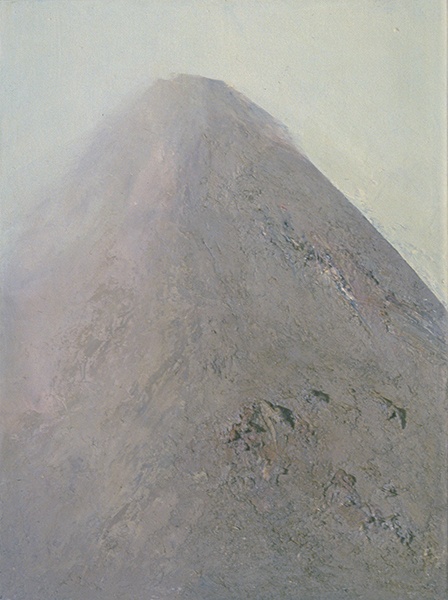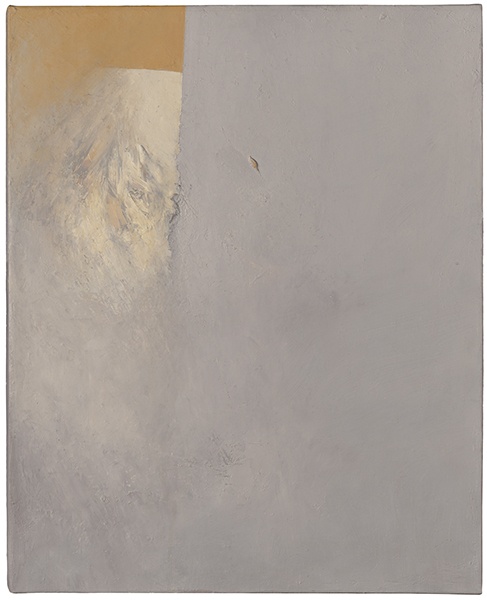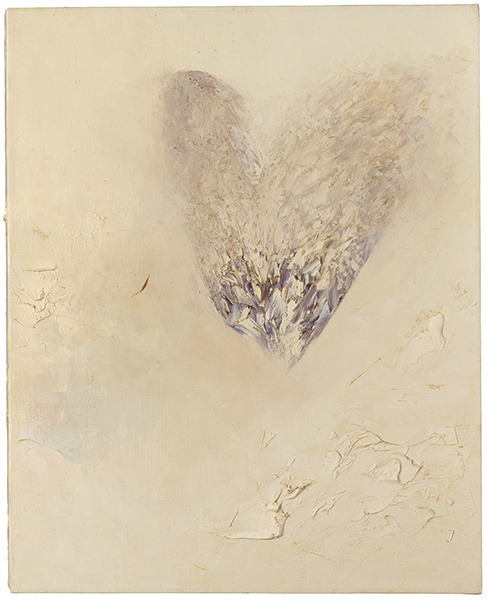Jay DeFeo: Selected Works 1952-1989
Goldie Paley Gallery, Moore College of Art and Design
University Art Museum, University of California, Berkeley
Artworks by Jay DeFeo in the exhibition
Exhibition Catalogue Essays
Think of Jay DeFeo Dancing to Count Basie Playing “One O’Clock Jump”
© Walter Hopps
Jay DeFeo has been one of the least seen and known of the truly brilliant artists to have emerged within abstract expressionism since World War II. I believe the strength and inventiveness of her finest art will come to be seen as rivaling that of Cy Twombly.
I met DeFeo, in San Francisco, in 1954. I followed her career and had the honor of exhibiting her work throughout the course of her life, which was sadly cut short in 1989. DeFeo worked intimately on paper, executing drawings and small painting studies; her paintings ranged from easel-size to heroically large. She also made sculpture from time to time, which ranged from tiny (the size of jewelry) to pieces more than ten feet high. Although much of her sculpture has been lost or destroyed, a vast and rich body of drawings and paintings still exists.
The stroke and touch of any material varied widely in DeFeo’s art. The bold, gestural landscape of Torso (1952) is of great variance to that of the finely controlled Young Bird of Paradise (Persephone) (1957). These, in turn, contrast markedly in technique if not spirit to the collage of photographic images in Blossom (1956).
Drawing is at the core of DeFeo’s art. Her drawings from the early fifties have a rugged, atavistic quality—atavistic in that they are tribal, primitive markings that exist prior or oblivious to Western urban traditions. Early drawings that are based on literal images, such as several from her Untitled (Florence) series (1952, E2775 and E1218) or Tree (1954), maintain a shamanistic distance from contemporary society. This primitive shamanism is akin to that found in the drawings of Joseph Beuys.
From the onset, DeFeo has been, for me, one of the very few artists to invoke overtones of ritual magic in her art. This is why I conjure up the quality of a shaman. The deep and subtle invocation of symbol and reference transcends the time span of historical reference or the more usual iconography drawn from Western art. From time to time, DeFeo made allusions to Western art traditions. Apparition (1956) alludes to Renaissance drawing and contains the psychosexual overtones native to surrealism. DeFeo fell in love with the music of Count Basie and painted Doctor Jazz (1958) as her response.
Throughout the seventies, DeFeo found curious and original ways to combine literal rendering in the detail of abstract passages. She saw the core of structural beauty in the most banal objects. Using a mix of three-dimensional rendering with the fully gestural, she created works that are perceptually dislocating and, over time, seem to grow in their connotations.
One must make note of DeFeo’s acknowledged masterpiece The Rose (1958–66), which involved the artist from 1958 to the end of her life. The first state of its creation occupied the artist for eight years. The process of this painting virtually consumed her; she worked on this piece with agonizing energy and attention. The final resolution was shown publicly, for the first time, at the Pasadena Art Museum, in 1969. As abstract or generalized as the image is, it became a monumental self-portrait. One can read the central image as a confluence of womb and volcanic crater. This painting stands as one of the most powerful images conveyed by a creative artist in our time.
© 1996 Walter Hopps
Walter Hopps is the founding director of The Menil Collection, Houston.
Mountain Climbing
© Constance Lewallen
Jay DeFeo has been called an abstract expressionist, a Beat painter, a Funk artist, an eccentric, a romantic, and a visionary. She was the darling of the small, avant-garde art and poetry world of San Francisco during the fifties. Everyone admired her; men loved her. Some, like Wallace Berman, tried to plumb the depths of her creative impulse. Billy Al Bengston wrote, “She had style, moxie, natural beauty, more ‘balls’ than anyone.”1 Ed Kienholz said, she had the “biggest underground reputation” of any painter he knew.2 She was courted by collectors, museums, and galleries. Yet, in the early seventies, because of her all-consuming involvement with her legendary painting The Rose, many had written her off. By the late seventies, though, DeFeo had reemerged as an artist and beloved teacher. A retrospective of her drawings that opened at the University Art Museum, Berkeley, in 1990, shortly after her death, was the first step in examining DeFeo’s full oeuvre. It is the intent of this survey—from the first works DeFeo did after graduating from the University of California at Berkeley, in 1951, to her last oil paintings, of 1989—to advance the process of clearing away legends and labels that surround her reputation and to arrive at a fuller appreciation of her originality, courage, generosity of spirit, and extraordinary achievement.
By the time she was ten years old, Jay DeFeo had lived in Hanover, New Hampshire, where she was born on March 31, 1929, San Francisco, rural northern California, and Colorado. After her parents’ divorce around 1940, she settled with her mother in the then small, provincial city of San Jose, California. DeFeo always knew she would be an artist, but had it not been for Lena Emery, her high-school art teacher, her firsthand contact with art would have been scant. Emery nurtured DeFeo’s innate talent and introduced her to modern art through books and occasional trips to the San Francisco Museum of Art.
DeFeo had further contact with the more sophisticated world of San Francisco proper through visits to her paternal grandparents. She and her parents even lived in her grandparents’ home for a few years while her father was finishing his medical training at the University of California at Berkeley, and Stanford University. Summers (and one entire year) on her maternal grandparents’ ranch, in Carbondale, Colorado, contrasted with the urban experience of San Francisco.3 DeFeo later cited these two disparate environments of her childhood as the source of the dual sides of her painting nature—the more organic and spontaneous versus the classical and controlled.
DeFeo was deeply affected by her parents’ separation. One painfully remembered day, Henry DeFeo took his nine-year-old daughter to the movies, bought her popcorn, sat her down in the lobby at intermission, and told her he had two other children and another “wife.” Although he left DeFeo and her mother to live with his second family, her father remained a dominant figure in her life. There was, for example, no discussion about where she would go to college. Her father insisted it be his alma mater, the University of California, although Miss Emery would have chosen for her the more adventurous California School of Fine Arts (CSFA).
At Berkeley, DeFeo’s talent was recognized by her professors. She was the first woman to be awarded the University of California’s Sigmund Martin Heller Traveling Fellowship, upon receiving her M.A. in 1951. (In their recommendation to the university, the art department intentionally replaced her given name, Mary Joan, with her nickname, the initial J.)4 The grant allowed DeFeo to discover firsthand the latest art in New York (she was impressed by Philip Guston). In Spain, she visited the recently opened caves at Altamira. She spent three months in Paris, visiting former fellow-student Sam Francis and studying prehistoric art in the Musée de l’homme. She then went on to London, where, in addition to the British Museum, she visited contemporary galleries, noting in a letter to artist Pat Adams, a college friend with whom she carried on a lifelong correspondence, that she admired the exciting “color and surface quality” of paintings by Nicolas de Staël. But it was Florence that had the most profound impact on DeFeo.5 There she painted prodigiously for six months (the cross motif in so much of her work of the period was inspired by the small wooden crucifix mounted on the pensione bedroom wall), and there the world of the Renaissance made itself felt, although it would not be manifested in her work until later.
DeFeo’s tempera and gouache paintings made during and just after her trip to Europe and New York are her most classically abstract expressionist works. They show her exploring various palettes and compositions. In Untitled (Florence) (1952), with its blazing orange bird pinned against the scumbled red background, DeFeo proves, as artist Fred Martin put it, that “hot frenzy can be imbedded in paint.”6 Just as convincingly, she conveys the somber, damp interior of a Gothic cathedral in a cruciform-dominated work of 1952 (E2775). If the bipartite division of the page of Untitled (Berkeley) (1953), created just after her return home, recalls Mark Rothko, the blue-bordered brown “table” receding in skewed one-point perspective of another untitled work of the Berkeley series (E1220) can be likened to the bilious-green pool table of van Gogh’s The Night Café. In both the mood is ominous.
Although such paintings contain many abstract expressionist tropes, DeFeo’s knowledge of East Coast or even West Coast abstract expressionist developments was very limited, although she soon came to know and admire Franz Kline’s dynamic black-and-white abstractions. The powerful influence Clyfford Still exercised on San Francisco’s California School of Fine Arts (now, the San Francisco Art Institute) did not, surprisingly, have much impact just a bridge-crossing away at the University of California in Berkeley. In fact, according to Fred Martin, who attended both schools, the art department at Berkeley did not consider what was going on at the CSFA “art” because the painting there “lacked form.”7 As for the New York School, information came predominantly through small black-and-white reproductions in Art News.
DeFeo deplored the conservatism of her teachers, who were, in her words, “working cubism to death.”8 (Hans Hofmann had taught there briefly in the thirties, and his legacy of cubist-based modernism had by then become academic.) She did, however, appreciate the grounding in art history she received and that continued to inform her work throughout her career. She was equally drawn to Renaissance and African art—a further defining of the dialectic that characterizes her work. She also benefited from the discipline demanded of her by Margaret Peterson O’Hagan, the sole woman on the faculty and, by all accounts, an inspiration to her students. Martin wrote of O’Hagan’s “passion and fire,” and said, “She knew art was important and she communicated it to all her students.”9 Pat Adams, who met DeFeo in O’Hagan’s class, agrees that “O’Hagan never left a doubt that we were artists.”10
Given these circumstances, DeFeo’s precocious mastery of the abstract expressionist idiom is even more impressive. Indeed, poet Michael McClure recognized her originality when he saw a selection of her paintings displayed in 1954 at The Place, a cafŽ in San Francisco’s North Beach, where artists and poets of the Beat generation congregated:
DeFeo’s work was a sudden esthetic illumination; pieces of posterboard with daubed single splotches of gray and white tempera and maybe a few stringy lines comprising part of a brush stroke or sweep of dirty red. But none of it was careless—it was perfect. And it was on perfectly worn and slightly uncared for backgrounds.11
When DeFeo returned to Berkeley in 1953 from her European sojourn, she moved back into the same large studio on Magnolia Street she had rented during her final year at the university. Of the dozens of motifs she had tried out in the previous three years, she held on to some—like the torso, the cross, the eye, and the bird—throughout her life. Torso (1952) combines the colorful, slashing strokes of her European works on paper with the stable, rectangular image similar to the “table” of Untitled (Berkeley) (1953) (righted, it becomes a body). Its elongated vertical proportions also point to many of the drawings and sculptural paintings that soon were to occupy her.
DeFeo’s interest in sculpture had been intensified during her travels in Europe, and she took advantage of her spacious studio (a former ballroom), with its fourteen-foot-high ceilings, to experiment with enormous plaster pieces and what now would be called installations, which she changed weekly. She made these by applying plaster to wood that she had previously wrapped with rags. When she had to move to a smaller place on Delaware Street in Berkeley, because she could not cover the rent, she destroyed many of her paintings and stored some of her plaster pieces with Manuel Neri, a sculpture student at the California College of Arts and Crafts (CCAC) in Oakland. Neri, who is now identified with the material, says it was DeFeo’s sculptures that suggested the possibilities of plaster to him. DeFeo continued to make sculpture on Delaware Street, which she called the “doll’s house” because of its sequence of tiny rooms, all painted by her in a different bright color. Lacking a large studio and ever adaptable to each new working situation, DeFeo began making miniature sculptures out of copperplate and wire.
Later in 1953 she met Wally Hedrick, a young painter from Pasadena, who had come to San Francisco to study at the California School of Fine Arts on the GI Bill. Urged by the painter William Morehouse to look up DeFeo, Hedrick arrived unannounced one day at her apartment. He noticed a stack of wood one-by-twos, the kind used for stretcher bars, by the front door, and knew he was at the right place. DeFeo, who thought Hedrick was delivering the lumber, leaned out the window, and said, “Bring it up.” Hedrick, dumbfounded, did. It seemed to him at that moment that DeFeo was the “most beautiful creature in the world.”12
Soon DeFeo and Hedrick moved to a small basement apartment on Bay Street, in San Francisco, which DeFeo remembered as being rustic and “fraught with atmosphere…very romantic.”13 DeFeo and Hedrick married on August 25, 1954, and she told Pat Adams, in a December 1954 letter, that her future with Hedrick looked bright. “What a delightful mess,” she writes of their new apartment. “We have a small place and it is simply a riot of Christmas glitter, wood shavings, straggly cats and an even stragglier Christmas tree and…hammers and saws and lots of paint, cigarette butts and just plain crap everywhere, Wally is building a great big box for a speaker and I’m struggling to get at whatever I am after in these peculiar Christmas decorations which appear to look like big colored pennants with streamers and glitter.” DeFeo went on to say that, for the first time, she was not suffering the depression that always followed her periods of creativity, and was relieved that she could be creative in a state of happiness.
The flat was only a block or so away from CSFA, where Hedrick would receive his B.A. in 1955. At the time, CSFA was the most advanced school of painting anywhere, thanks to the former director Douglas MacAgy, who had given new life to the school when he became director in 1945. He was responsible for hiring Clyfford Still in 1946, a powerful painter and personality, whose viscous brand of nature-related abstract expressionism and romantic vision of the artist going it alone in the face of a hostile public defined the school for years to come. MacAgy also brought Mark Rothko and Ad Reinhardt from New York to teach summer sessions. Between 1946 and 1950, the abstract expressionist painting being developed by faculty and students of CSFA, many of whom were older GIs, was as advanced as that evolving independently in New York.
Partly because she did not have a proper studio on Bay Street, DeFeo concentrated on her small wire objects, which were developing into highly original jewelry. At first she saw jewelry-making as a way to earn money. She was having difficulty finding teaching jobs because, while living in Berkeley and low on funds, she had been convicted of shoplifting two cans of paint from a hardware store near CCAC, where she was teaching children’s classes. As a result she lost her teaching credential and would not be asked to teach for several years. She had some success selling to a boutique that handled custom jewelry,14 but when the demands of production became too onerous, she lost interest. DeFeo, however, credited her copper disc pieces as being miniature foreshadowings of her masterwork, The Rose. The jewelry also shows up in many of DeFeo’s object drawings of the seventies. At the time, though, she wanted desperately to get back to painting, and as soon as she and Hedrick moved to a roomy, ramshackle flat at 2322 Fillmore Street, where they each had large studios, she started painting again.
October 7, 1955, is the date usually cited as the public emergence of the San Francisco renaissance, for it was on that Friday evening that Allen Ginsberg read “Howl,” for the first time at the Six, a cooperative gallery at 3119 Fillmore Street. Hedrick, one of the founders of the Six, had asked McClure to organize a poetry evening, a task McClure, about to become a father, passed on to Ginsberg. The core of what became known as the Beat poets was on hand to read that evening; in addition to McClure and Ginsberg, this included Gary Snyder, Philip Lamantia, and Philip Whalen. Kenneth Rexroth was emcee, and Fred Martin’s sculptures were displayed on the stage. Among the artists and poets in the audience were Jack Kerouac, Lawrence Ferlinghetti, Neal Cassady, DeFeo, Hedrick, Neri, Ronald Bladen, Al Held, and Yvonne Ranier.
The small group of artists and poets who revolved around CSFA, the King Ubu, and, later, the Six and Batman galleries, the Cellar and the Place cafés, and Ferlinghetti’s City Lights Bookstore, in North Beach, shared not only a devotion to their own crafts but to jazz, which had flourished in San Francisco since the forties and symbolized the rejection of the stultifying conformism and materialism of the McCarthy-Eisenhower years. Moreover, bebop’s fusion of erudition and intuition was a perfect analog for the Beat philosophy. DeFeo was deeply involved in jazz, especially female vocalists like Bessie Smith, whose 78s she bought at the Black and White record store, on Fillmore Street.
DeFeo and Hedrick’s circle included painters Joan and William Brown; Sonia Gechtoff and her husband, James Kelly; Deborah Remington; Bruce and Jean Conner; and poet Michael McClure and Joanna McClure. Artists Wallace Berman15 and George Herms served as links to Southern California, moving between Los Angeles and San Francisco. Several lived or hung out at 2322-24 Fillmore,16 the hub of the small but lively, overlapping art, poetry, and jazz worlds. The poetry and jazz worlds were practically inseparable; many poetry readings were backed by jazz and were as likely as not to take place in one of the co-op galleries. Meanwhile, the poets kept tabs on what the artists were up to.17 Hedrick remembers McClure and other poets “in their dark overcoats”18 visiting DeFeo’s studio regularly. Each Christmas, three to four hundred people turned up for a legendary party, dancing to the Dixieland and blues music of the Studio 13 Jazz Band, in which Hedrick played. For months before Christmas, beer was fermenting in the only bathtub, and during the festivities a large washtub with dry ice not only chilled the beer but covered the floor with “fog.”19
For all of them, the late fifties was a period of intense friendships and creativity. During 1956 and 1957, DeFeo and Gechtoff, painting in adjacent studios, seemed to have been reading each other’s minds. Drawings like Gechtoff’s August (1956) and Large Drawing (1956–57) are coalescences of layered, linear graphite lines similar to those of DeFeo’s Young Bird of Paradise (Persephone) (1957) and Untitled (1957); and DeFeo’s Song of Innocence (1957) and Gechtoff’s mysterious, atmospheric Painting #4 (1956) share more than a family resemblance. The palette knife became their tool of choice. But DeFeo was moving away from the painting-a-day mentality of Gechtoff and others and evolving a distinctive style—abstract and expressionistic, yes, but austere, iconic, and centrally focused. She manifested an increasing tendency to labor over works, to build them up for weeks and months. It is true that thick impasto surfaces were somewhat of a hallmark of West Coast abstract expressionism and can be seen, albeit less extremely, in contemporaneous works by Frank Lobdell, Ronald Bladen, and Jess (as well as in several contemporary European artists, such as Jean Dubuffet, Jean Fautrier, and Antoni Tàpies), but DeFeo took her painting further in the direction of sculpture than others would dare. The critic Thomas Albright pointed out the tendency of the abstract expressionists of DeFeo’s generation to emphasize the “materiality of materials,” but often to “highly cosmetic, or ‘confectionistic’ effect.” DeFeo’s works, on the other hand, were “raw and volcanic, and yet somehow also evocative and vulnerable, a rare monument to ‘ugly’ beauty.”20
DeFeo’s mid- to late-fifties’ canvases—Origin (1956), The Annunciation (1957–59), The Veronica (1957), Incision (1958–61)—were remarkably ambitious in scale and intent, a search for essences. Origin was her first major work and the first she spent a month painting. In Origin she locates the beginnings of life in the upward swells of thick grisaille paint. In The Veronica layered swaths of paint climb the high vertical support. She continues to evoke growth and florescence in The Veronica (the swooping forms also allude to the bullfighting pass for which the painting is named). She explained that she restricted the color in these and other works to temper their flamboyant forms and textures.21 However limited the color, she exploits the rich potential of her chosen palette. The shades of white, gray, tan, and black in Origin are too numerous to count, and close inspection reveals an occasional daub of red or green underpaint. Similarly, the browns in The Veronica range from nearly black to a creamy tan as rich as mocha icing.
The torso motif reappears in shimmering blue and silver, with a smattering of brown, in The Annunciation. Here it emerges glowingly from a dark background and ascends heavenward. Renaissance painting was on DeFeo’s mind, surely, and she elaborates on the meaning of The Annunciation in a letter she wrote to J. Patrick Lannan just after he purchased it from her 1959 one-person show at the Dilexi Gallery, in San Francisco:
I painted this kind of winged vision which announces in my eyes or promises some realization of all that is good in this existence, and more specifically it is a promise to me of the realization of certain powers creatively—and when I say that, I make some association between the words creative and spiritual or divine. Or at least I feel this way when I am doing my best…I don’t choose such titles with any narrow Christian interpretation in mind. It doesn’t have to do with any specific religion at all. It is only a symbol. I have to make my own philosophy or religion in my life and I’m too young to understand it as yet. I only have occasional moments of understanding and awareness of the matter when I see what I have painted in a moment of objectivity. Otherwise the whole process is intuitive—and probably why I’m so slow. If I knew more about what I’m doing I wouldn’t have to sit around mulling it over in my mind for months.22
Song of Innocence (1957), a smaller and less impastoed work of the period, is no less affecting. In it, DeFeo perfects the flickering brushwork seen in sections of Origin, The Veronica, and The Annunciation, and comes as close as she ever does to eliminating an image. Centrifugal movement around a luminous center—here, like a spray of stars in a night sky—is a feature of many of her paintings and drawings from this time on.
At the end of this terrifically productive cycle, DeFeo manifested her personal spiritual quest in representational terms. The Eyes (1958), a four-by-eight-foot pencil-on-paper drawing of her eyes, is unlike any work she had done before. The vertical lines that cross the eyes at irregular intervals only emphasize their haunting gaze. DeFeo said that the image came to her in a dream, as if foretelling of an important event. Philip Lamantia’s lines for which it was titled—
Tell him that I have eyes only for Heaven
as I look to you
Queen mirror
of the heavenly court23
—did not inspire the drawing but reinforced its necessity. Other artists have represented themselves in a similar fashion. For example, the young Piet Mondrian did a series of self-portraits dominated by his dark, penetrating eyes in 1908–9. In one, he, like DeFeo, represented his eyes only (although DeFeo’s eyes, with clear white pupils, and entirely disembodied, are more eerie). In both the Mondrian and DeFeo self-portraits, the eyes transcend representation and become symbols for visionary sight. The Eyes is a hypnotic and powerful work24 that leads directly to The Rose. (Even earlier, while still a graduate student, she wrote a letter to her professor John Haley about her aspirations in painting, stating she wanted to create an image “about being on ‘an edge’…precariously balanced.”)25
In 1958 DeFeo began two paintings, more or less simultaneously, with only one preconceived notion, that both would have a central or solar point from which rays would emanate (a more symmetrical and structured variation of the composition of Song of Innocence). She then proceeded to approach The Jewel (1959) and The Rose oppositionally: The center of The Jewel is convex, while that of The Rose is concave; the ray lines in The Rose are incised into the thick paint (eight inches at its deepest point); in The Jewel, they are dimensional planes meeting at the axis and gradually flattening as they move toward the perimeter. The Rose is composed primarily of white and grays; the colors in The Jewel go from white (with a visible undercoating of red) at the midpoint to sienna, to deep red and, finally, to the red black that forms the background. Throughout her career, DeFeo made pendulum swings from color to monochrome, from thickness to flatness, from expressiveness to restraint, sometimes within a single work, and, as in these two pivotal works, she often played one painting off another. The Jewel, like its name, is bright and hard; The Rose is subdued and organic, or, as Bill Berkson has observed, “The Jewel is a flash, The Rose is a tremor.” The almost baroque elaboration of form in The Rose is held in check by its fairly rigid design, while the more angular articulation of the image in The Jewel contains deep, organic fissures, gashes, open wounds. It was this desire to balance expressionism with refinement and restraint while maintaining “the spirit and freshness of the abstract expressionist idea—the spontaneity…with the growth of the image from layer to the rest” that distinguishes DeFeo from other first- and second-generation abstract expressionists.26 What is more, DeFeo was never a field painter. Although The Rose has sometimes been compared to Jasper Johns’s contemporaneous target paintings, because they share emblematic imagery embedded in a thick, tactile surface, Johns’s targets are vehicles for field, that is, non-hierarchic compositions, while DeFeo, who considered herself a symbolist and an expressionist, needed an image, however abstract, that was more than a compositional hook.
DeFeo was not the only artist who was using the mandala or sunburst form. In 1959 Hedrick was represented in “Sixteen Americans,” at the Museum of Modern Art, in New York, by four mandala paintings, and the somewhat older Dynaton artists, including Wolfgang Paalen and Gordon Onslow-Ford who were working contemporaneously on the West Coast, used the mandala as a cosmological and mystical symbol intended to stimulate meditation. According to Hedrick, however, he and DeFeo were not influenced by the Dynaton artists, who were, he said, “too mystical for us.”27 For DeFeo The Rose was an archetypal form, a permutation of the cruciform, which accounted for its universal appeal. In the sixty-third entry of McClure’s “100 Things of Interest about the Assemblage Movement,” he describes an earlier cruciform work of DeFeo’s:
It was of butcher paper stretched over a lumber frame in the shape of a cross, around twelve to fifteen feet high. It was outrageous in scale and beauty—it had an enormous delicacy. The white cross’ sole decoration was a large splash or splot of tempera. The piece was graffitied by vandals while hanging in the museum. The added obscenities worked to make the piece even more profound and consequently more beautiful.28
DeFeo referred to the splash of (red) color at the crossing of the arms as a “jewel, a great big gaudy jewel,”29 and it is likely that in that cross lay the seeds of The Jewel.
Just after embarking on her more than seven-year struggle with The Rose, DeFeo had a one-person exhibition at the Dilexi Gallery, in San Francisco, a professional operation owned and directed by James Newman. Both J. Patrick Lannan, a major midwestern collector, and Dorothy Miller, a curator at New York’s MOMA, saw the show independently. Miller was talent-scouting for her “Sixteen Americans,” an exhibition to take place later that year. Lannan and Miller also visited DeFeo’s and Hedrick’s studios within days of one another and saw The Rose (then called Deathrose) in progress. Miller chose a number of paintings by DeFeo and Hedrick for “Sixteen Americans.” (Among other artists in that landmark exhibition were Frank Stella, Jasper Johns, Robert Rauschenberg, Ellsworth Kelly, Alfred Leslie, Louise Nevelson, and Richard Stankiewicz.) Miller wanted to include The Rose (and both MOMA and Lannan were interested in purchasing it), but DeFeo refused, wanting to continue work on it. Lannan was so struck by her work that he bought The Annunciation and five large drawings.
In 1961, DeFeo was one of Dorothy Miller’s picks in Art in America’s “New Talent U.S.A.,”30 and the following year she was featured (upon a stepladder, working on The Rose) in John F. Kennedy’s “The Arts in America,” in Look magazine.31 Around the same time, British art historian and critic John Russell visited DeFeo’s studio and, according to DeFeo, “He was very moved by the painting.”32 These auspicious events might have signaled the beginning of a bright career were it not for DeFeo’s unwillingness to capitalize on them. While interest was growing in her work, she was committed to The Rose, without a clue as to how many years of her life it would take. Added to commitment was youthful naïveté: “Wally and I didn’t realize the prestige of being included in such a show [referring to “Sixteen Americans”]…. It really surprises many people that we were the only people included in that show who didn’t make an effort to go to the opening.”33 They gave away the plane tickets MOMA had sent them.
Much has been made of West Coast artists’ devotion to the personal and mystical, a tendency articulated often by the late San Francisco critic and champion of local expressionism Thomas Albright and elaborated upon by Richard Cándida Smith in his Utopia and Dissent. Cándida Smith distinguishes between the West Coast penchant for the “cosmological-theosophical over psychological-sociological” orientation of the East Coast.34 While it is true that Still’s romantic expressionism saturated the San Francisco atmosphere, spiritual concerns were also at the heart of such New Yorkers as Mark Rothko and Ad Reinhardt, both of whom, it so happens, taught summer sessions at the CSFA between 1947 and 1950. Whether or not one accepts Cándida Smith’s thesis as a general condition, however, one can certainly see DeFeo’s personal obsession in those terms.
The Rose occupied DeFeo almost exclusively from 1958 to 1966. By then, it had accumulated a ton of paint and had to be forklifted from DeFeo’s studio, an event recorded in Bruce Conner’s elegiac film The White Rose. (Bill Berkson’s essay in this catalog details the creation of this masterpiece and its aftermath.) According to Bruce Conner, only an “uncontrolled event” could have caused her to stop working on The Rose,35 and this came in the form of a large rent increase in 1965 that forced DeFeo and Hedrick to vacate their apartment. DeFeo followed The Rose to the Pasadena Museum at the invitation of director Walter Hopps, who, when running the Ferus Gallery in Los Angeles, and even before, had exhibited and promoted DeFeo’s work since the fifties. For three months, DeFeo continued to add “refinements” to the work in Pasadena, until she returned to the Bay Area. Hopps had planned to show the painting soon after, but many delays ensued, and the painting was not exhibited in Pasadena until early 1969. Later that year it was shown at the San Francisco Museum of Art, and from there it came to the conference room of the San Francisco Art Institute, where it remained until the summer of 1995, most of that time hidden behind a layer of plaster and a fiberboard wall.36 The Whitney Museum of American Art’s acquisition of the painting made possible a complicated but successful conservation in time for the painting to be included in the Whitney’s “Beat Culture and the New America: 1950–1965” in the fall of 1995.37
The completion of The Rose, in 1966, marked the beginning of a difficult and fallow period for DeFeo, brought on by psychological and physical exhaustion and ill health, and exacerbated by the breakup of her marriage. It also symbolized the dissolution of the tight community of avant-garde artists and poets, of which DeFeo had been a galvanizing member. Many of DeFeo’s friends, such as Gechtoff, Kelly, and Remington, had moved to New York, and others were settling into teaching jobs and more or less isolated existences.
DeFeo moved to Marin County, first living in Ross and then in Larkspur, and supported herself by teaching part-time at the San Francisco Art Institute and other local schools. In 1967 she met John Bogdanoff, who remained her companion throughout the seventies, and for the first time in her life, she did not make art, go to galleries, or read art magazines. Instead, she participated in the counterculture milieu of the time. Among her friends was Dave Getz (former neighbor at 2322 Fillmore), of Big Brother and the Holding Company, to whom DeFeo lent her Bessie Smith recordings, which, in turn, inspired the group to take on Janis Joplin as a vocalist. DeFeo later viewed this period as the adolescence she had never had, but by 1970 she was ready to slowly resume making art.
The first piece she made after The Rose was After Image (1970), a modestly scaled collage based on a photograph of a shell in the shape of an eye (and the precise size of one of the eyes in The Eyes), which seems to have just broken through a film of translucent paper. Thomas Albright wrote to DeFeo after seeing the piece exhibited, along with several other of her works on paper, at The Oakland Museum in the summer of 1971: “It’s a curious thing about those creases and torn edges and faded colorations; maybe they weren’t consciously intended, but I thought they were immensely effective, projecting a kind of feel of age and decay through which the images, for all their fleeting, elusive qualities, manage to persevere, like some magical symbol discovered on an ancient papyrus manuscript.” The shell image also contains the flange motif of The Rose. These convergences with earlier work gave DeFeo a starting point from which to develop her vocabulary. It was also at this time that DeFeo, like artists everywhere, became interested in mechanical reproduction, particularly photography (photography as a tool for photorealist and conceptual artists was becoming widespread). With the assistance of some of her Art Institute students, she learned to make and process her own photos in a primitive home darkroom. She incorporated photographs and photocopies in a highly original series of photocollages made in 1973. Earlier, she had made two large collages, Blossom (1956) and Applaud the Black Fact (1958), composed of fragments of reproduced photographs of body parts, mostly nude female pinups (although a horse dangles precariously in Applaud the Black Fact), arranged in the form of a cross or pinwheel, another variant of rotation around a center. DeFeo recalled that Wallace Berman was “intrigued” by these collages,38 and Bruce Conner credits these works as well as DeFeo’s inventive Christmas wrappings—“string, colored paper, lace, and jewelry and hung…from the ceiling”—with having directly inspired several hanging assemblages, including The Lady Brain (1960).39 But after attempting a mural-size collage, “which was going to encompass just about every facet of human existence,” she became “frustrated with the poetic associations of the visual images” and abandoned it.40 She was always primarily an expressionist painter, who found her image through the process of manipulating paint. She simply did not think of her photocollages as important. Nor did she take seriously her photocollages of the early seventies; she once called them “after hours fun things.”41
One of these (E1210) includes Conner’s telephone dial, a reference to their marathon telephone conversations in 1973.42 (Looking closely behind the dial, one can discern several cut-out photos of roses.) As a close friend and an admirer of The Rose, Conner had initiated a drive to conserve the painting, by then seriously sagging under its own weight, and to sell it. DeFeo was equally concerned about The Rose’s welfare, but, as Conner noted later, was “too emotionally troubled to help much.”43 To make matters worse, she was laid up for a time with a cracked rib and a twisted ankle from two separate accidents (one, a fall from a ladder), and in 1971 had lost her teaching position at the Art Institute.44 DeFeo and Conner also had long discussions about the difficulty they were both having in coming to terms with their work and their mutual disaffection from the gallery and museum scene; they even questioned why they were “bothering to make art at all.”45
With After Image DeFeo had started to make art again, but she was still casting about for a new direction. It was at Conner’s suggestion that she began to photograph objects she had around the house—an old telephone, broken crockery, a lightbulb, a golf bag—to stimulate her imagination. As in After Image, she sometimes relied on forms in these collages that referred to her earlier works. Untitled (for B.C.) (1973),46 for example, is constructed of two identical photographs of a cactus placed end to end, as if one were a reflection of the other. The mirror-image spray of leaves clearly harks back to radiating spokes in The Jewel. For one of her “telephone” collages (E1282), DeFeo cut the silhouette of an old upright telephone from a photograph she made of a sheet of music composed by Conner that he had sent her.47 In another (E1281)—one of DeFeo’s most engaging —a golf bag with a hanging flame lightbulb approximates the shape of an upright telephone and its appended receiver. Like Picasso in his found-object sculptures of the early thirties, DeFeo recognized the formal resemblances among things, irrespective of function, material, or scale, and recombined them in inventive and often amusing ways.
It is one of the sad ironies of the story of The Rose that of the thirteen or so individuals and institutions that had been eager to acquire it in the sixties, including Lannan and the Museum of Modern Art in New York, none responded to Conner’s and DeFeo’s importuning in the seventies. Museums were wary in the face of the deteriorating condition of the work. Their demur, though, probably had more to do with the world of 1972, which was a far different place from that of the late fifties when the painting was in demand. Abstract expressionism, to which The Rose was linked, was over, and DeFeo, living in isolation and not exhibiting, was all but forgotten. Enough money was scraped together to stabilize The Rose—DeFeo contributed funds from the 1973 N.E.A. Individual Artist Fellowship she received—and Conner and DeFeo resigned themselves to that partial and temporary solution.
During the seventies DeFeo produced a large body of work on paper. Circumstances played a part; her Larkspur studio, an eight-by-sixteen-foot converted screened-in porch, was too small for her to work in oil paint or on a large scale. Moreover, as in the early fifties when she was traveling in Europe, she found that working in a small format was not only convenient but allowed her to recover a lot of ground lost during her four-year hiatus from artmaking. DeFeo enjoyed investigating the properties of acrylic paint, which she was using for the first time, and she found ways to adapt it to her intuitive, add-and-subtract method of building an image. The distinction between drawing and painting is further blurred in DeFeo’s work, because she habitually combined paint with drawing materials, such as pencil, charcoal, and pastel, responding with great sensitivity to the materials at hand. She never attempted to cover her tracks; each work is a palimpsest, a record of its own making. In a November 1973 letter to Pat Adams, she described her process as “a slow sort of pastel and charcoal drawing technique separated by layers and layers of medium until a kind of translucent effect (almost 3-D sculptural in quality) is attained.”
Since working in acrylic did not allow for the physical impasto that characterized her oil paintings, DeFeo drew on her earlier study of Renaissance painting to create the illusion of space through perspective and chiaroscuro. The decidedly new look of her Marin County works is attributable to their subject sources. No longer was she looking to nature as a metaphor as she had, for instance, in Origin and Incision; rather, continuing the practice started in her photocollage series of 1973, she took her subjects from man-made objects she had in her house, such as swim goggles, a shoe tree, a cup handle, and the jewelry she had made—objects with smooth surfaces and defined edges. A Scotch Tape dispenser inspired the loose and delicate circular form in Veil (1979) (central focus and circles and their permutations—eyes, apertures—are enduring motifs in DeFeo’s repertory). Here the form is smeared and rubbed until, at the edges, it dissolves into nothingness; the inorganic becomes organic. The same tape dispenser is transformed into a series of concentric circles that seem to spin nearly out of control in One O’clock Jump Series: Antechamber (1979). It is a measure of DeFeo’s mastery that starting with a cheap, mass-produced, plastic object, she could evoke the cosmos. A pair of mixed-media drawings, Black Guard (1978) and White Knight (1978), are among her most architectonic compositions. Like the other works of this period, the mostly dark Black Guard and its lighter counterpart retain abstract expressionist smudges, erasures, and random marks of process. In a completely unexpected move, though, she further activates Black Guard with a number of metal staples that reflect the light like military medals. When DeFeo did not completely obscure the model, she gave it multiple identities. Figure II (1976) is one of a long series of paper works based on a camera tripod. In most, the tripod doubles as a jaunty, robotic figure in full stride. It also provides DeFeo with another variant of the radial imagery that dominates so much of her work.
DeFeo preferred Cézanne to the impressionists—that is, structure to surface effects. The Jewel and The Rose, for all their excesses, are held in check by a fairly rigid symmetry. In the seventies, DeFeo emphasized the structural over the gestural, and simplicity over complexity. The overall effect of her work of this period is of quietude and distillation, of paring down to essences. Knute Stiles, writing in Art in America, called DeFeo’s aesthetic “very Zen,”48 and in the Village Voice, he noted the drama and monumentality of her drawings.49 As in all her work, DeFeo sought a synthesis of refinement and expressiveness. If, in the seventies, she leaned more toward the former, it was, in part, a response to the reductive vocabulary of minimalism, the predominant style of the time. But as Origin, The Annunciation, and other paintings of the fifties are DeFeo’s unique responses to abstract expressionism, these works—despite the influences of photography, photorealism, and minimalism, and passing resemblances to works by other artists (one thinks of Jim Dine’s paintbrushes and tools and Lee Bontecou’s elegant, monochromatic “ocular” drawings)—are completely her own.
DeFeo achieved her nearly seamless blending of abstraction and figuration by sketching with her camera—enlarging or reducing the size of objects, isolating and photographing them from various angles. This accounts for the metamorphosis of a used gum eraser into a torqued, quasiarchitectural triangle in Temple (for W. B.) (1980),50 as well as for the dramatic transmutation of DeFeo’s small dental bridge in the Crescent Bridge diptych (1972). Isolated and lacking scale or other contextual information, the bridge takes on the aspect of a monumental rock formation. DeFeo described her work of this period as “placing large single, rather organic forms of a provocative but unspecific nature in spaces that appear limitless beyond the boundaries of the panel,” noting that where she had always been preoccupied with this concept, with acrylic paint she was able more closely to define the images.51 In Crescent Bridge I the gray and yellow-white craggy forms are thrust diagonally into the stark white background. The transformation is intensified and even more theatrical in Crescent Bridge II, where the deep-black ground reads as a starless night sky, an endless space, against which the luminous gray forms float mysteriously. Their title is quite literal—when the Crescent Bridges are hung alongside one another, they form a crescent arc—but it also alludes to the bridge that these works formed between DeFeo’s old and new life.
Like The Jewel and The Rose, Crescent Bridge I and II complement one another through opposition, a practice that becomes even more obvious in future works. We see it again in Lotus Eater I (1974) and Lotus Eater II (1974), which are painted on six-by-four-foot Masonite panels. (DeFeo, with the aid of a reducing glass, did manage to make a number of relatively large paintings in her cramped Larkspur studio.) The amphoralike shape of the Lotus Eaters harks back to DeFeo’s 1958 Doctor Jazz, a tall oil-on-paper work in which a vessel rises out of a heart-shaped base.52 The Lotus Eaters, too, can be seen anthropomorphically, as headless female torsos.
DeFeo lost several teeth as a result of overexposure to the materials she used in painting The Rose (hence, the need for the dental bridge of the Crescent Bridge diptych). In September Blackberries (1972–73), she arranged cut-out and collaged photographs of her teeth like scattered berries on a photograph of a seashell, a punning reference to Michael McClure’s eponymous poem. The verisimilitude of September Blackberries and The Eyes was not typical of DeFeo, who more often than not masked her subject.
There was, however, a brief moment in the early seventies when DeFeo made her source manifestly concrete. Exquisitely rendered, Isis and Makara (both 1972) stand alone in DeFeo’s oeuvre. The rounded, draped, and headless figure, named for the Egyptian goddess, Isis, is another of DeFeo’s torsos, but the only one DeFeo rendered realistically. Isis, rounded and tightly draped, has the weight and metallic finish of a bronze statue, an illusion abetted by the pearlescent sheen of the gloss medium DeFeo used. It is the companion to Makara, the name, in Indian mythology, of a fantastic animal, similar to a crocodile. Mythological references aside, the formal elements in Makara—such as the spiral of the coil of the tail and the shell next to the animal’s jaw—are those found repeatedly in DeFeo’s work. These two paintings are among the clearest reflections of her recurrent urge to look to art history, expressed more subtly in the small photograph of the African mask collaged onto the tripod head of Figure II (1976). Both images were inspired by reproductions, but considerably altered from their source. Unlike the photorealists, DeFeo had no interest in tour-de-force fidelity to a photograph. She was more interested in seeing what she could do with acrylic materials. She said she never could have made such dimensionally suggestive images in oil, but with acrylics she could alternate paint layers with glazes to build up the illusion. Although the same applies to all of DeFeo’s inaccurately dubbed monochromatic works, the tonal variation in Isis and Makara is especially rich—blacks, tans, and grays modulate between warm and cool, matte and glossy, smooth and rough.
DeFeo was included in some group exhibitions and had two local one-person shows during the seventies, but it was not until 1980 approached that significant exhibition opportunities arose. In 1978, she was invited to show recent works on paper concurrently in the MATRIX series of the University Art Museum, Berkeley, and the Gallery Paule Anglim, in San Francisco. Critical response was encouraging. Andrea Liss wrote, in Artweek, “DeFeo is an artist with the spirit of a fighter and a poet.” She praised DeFeo’s art for “its ability to hold opposing forces in harmony and its humanistic refusal to succumb to a doctrine of dogmatism.”53 Melinda Wortz, in Art News, called the Anglim show “illuminating and rewarding,”54 and in the Village Voice, Knute Stiles thought it was “the strongest show of the season.”55 The following year, in Hope, Idaho, DeFeo showed paintings at Ed Kienholz’s Faith and Charity in Hope Gallery, and the University of Idaho, in Moscow. (For the former, she resurrected The Jewel, which she had put aside when she began The Rose, from its storage place under her house.)
After teaching part-time in a half-dozen art schools and universities, including the University of California at Berkeley, DeFeo welcomed the offer in 1982 of a full-time position at Mills, a private women’s college in Oakland. Mills’s invitation came at an especially opportune time, as DeFeo was despondent over her recent separation from John Bogdanoff. At Mills, however, she soon felt part of a community again, respected by her fellow faculty members and loved by her students.56 In early 1982 she moved to a large, live-in loft at 1232 19th Street, in Oakland, and in 1984 she used a small inheritance from her mother to add a large, new studio onto the space. For the first time in over a decade, she had ample financial and physical resources. At first intimidated by her new, spacious studio, she tended to work in a small corner, but before long was stretching large canvases and buying oil paint again. She was thankful not to have to “play rotation games every night,” as she had in Larkspur, in order to see one work next to another.57
DeFeo continued to produce low-key-palette paintings in the eighties, often in pairs, like Arcturus I and II (1984–85) and Hawkmoon I and II (1985), and triads—Summit Ridge Drive I, II, and III (1980–81). The infinite space of Crescent Bridge II is again evoked in Arcturus I and II. These dramatic paintings are a compendium of contrasts: gesture and geometry; startling, encrusted white highlights against dark, thinly brushed fields; matte areas relieved by shiny passages. By arranging elements along diagonal compositional lines, DeFeo makes these heavily textured arcs soar. If her paintings of the fifties were symbolic abstractions of earth forms—mountains, plants—many of her works of the seventies follow the lead of Arcturus I and II and look to the sky, suggesting shooting stars or meteor showers. (Song of Innocence [1957] foreshadows this direction.) In La Brea (1984–85), for example—the first painting DeFeo made from start to finish in the new studio—slashes of bright white, red, orange, and blue explode like fireworks from a dark surround. La Brea is one of her most gestural and least imagistic late paintings. The more brooding and muted Blue Nile (1986) combines gestural sweeps and paint drips with hard white lines.
In general DeFeo had moved away from the machinelike, referential imagery of the seventies as well as from the circular, radial, or centrifugal motifs of much of her previous work. In the eighties, the triangle, rather than the circle, dominates her oil paintings—Verdict I (1982) and Verdict II (1982), Red Direction (1985), Apex (1984)—and drawings alike. Sometimes, as in Blue Nile, but also in Geisha I (1984–87) and Baja (1983), a triangular form juts in from the edge of the canvas, or, as in Verdict I, it points across the canvas like a fiery arrowhead. In Verdict I, DeFeo held geometry and gesture in a dynamic tension. Thickly painted passages of coagulated yellow and red blotches are cut through with bands of color. An inverted V, painted red with a black border, is echoed by a strip of red tape, folded over and protruding from the surface plane. The bright cream-colored background is unmarked except for drips of gray, black, and yellow paint that splashed the bottom area as a result of her vigorous brush and palette knife activity.
Trips to Mexico, New York, Japan, Africa, and Europe with colleagues and former students punctuated the last decade of DeFeo’s life. She visited old friends—Deborah Remington, Sonia Gechtoff, James Kelly, and Clinton Hill—in New York over the Christmas holidays in 1981–82 and 1984–85. Accompanied by Ursula Cipa during the latter trip, she made several visits to the de Kooning retrospective at the Whitney Museum. Traveling with fellow Mills professor Mary Ann Lutzker in 1987, she delighted in the vibrancy of Tokyo, Kyoto, and Hong Kong. During her final trip, to Africa, with former student Betty Jo Costanzo, in 1988, she hiked to the top of Mt. Kenya, fulfilling a lifelong fantasy. According to Hedrick, he and DeFeo shared an intense, romantic fascination with mountain climbing and especially with the 1953 Mt. Everest expedition of Sir Edmund Hillary, the first climber to reach the summit and return. Hillary’s heroic exploits (along with, perhaps, her memories of Colorado) no doubt stimulated DeFeo’s 1955–56 “mountain” series (The Rose is painted over a failed one) and continued to inspire her.
Climbing a mountain is an apt metaphor for DeFeo’s life, and never more so than her last years. Less than a year after returning from Africa, she was diagnosed with lung cancer. Following surgery, she continued to teach and paint while undergoing treatment. She said of the ordeal, “You do the best you can each step of the way…the imminent presence of death is always there.”58 It is no surprise then that mountain imagery appears frequently in DeFeo’s last paintings. In their reference to landscape, they connect to her large-scale works of the fifties, although they are never larger than sixteen by twenty inches. DeFeo had started making small oil paintings on linen in 1986 with the Alabama Hills series, and during her illness continued to explore ways to achieve monumentality in a small format. She derived inspiration for these sensitive and spontaneous works from Manet’s sixteen exquisite, small flower paintings produced during his final illness.
Art historian and Mills colleague Moira Roth describes these works—La Angostura (1988), Red Summit (1988), Cross Section (1988), Brown Mountain (for J. B.) (1989)—as “mountain peaks and crevices sighted incompletely and suddenly in the clearing of a mist or illuminated by a bolt of lightning in the night.”59 DeFeo thought of them as fantasy landscapes, obviously not painted from nature but meant to “conjure up a kind of landscape feeling.”60 (They were, no doubt, stimulated by landscapes she observed on her travels, especially the spectacular Mt. Kenya.) More than representing mountains, paintings such as Brown Mountain (for J. B.) are like chunks of matter itself; its tan, scumbled surface, for example, mimics the dry, rocky earth of California, or, perhaps, Africa. It is dedicated to Joan Brown, who admired it, and with whom DeFeo had reconciled after years of estrangement. Brown was able to empathize with DeFeo, since she herself had been treated (successfully) for breast cancer. She introduced DeFeo to the teachings of the Indian holy man Sathya Sai Baba, which gave DeFeo comfort.61
Not all of DeFeo’s small paintings are roughly textured. Multicolored, flickering daubs characterize Alabama Hills #13 (1986), La Angostura, and Dove One (1989), which are, according to the artist, the closest she ever got “to impressionism…a sense of atmosphere through color.”62 (Be that as it may, sections of much earlier works like The Veronica and The Annunciation are comparable.) With a perfectly placed smear of gray that cuts across the edge of the peak in Alabama Hills #13, DeFeo paints the lingering mist of an early morning. Stippling red on black, she evokes the last rays of sun burning the steep face of Red Summit. In Dove One, the staccato paint application suggests the flutter of wings of a black-eyed bird—a soft, grayish dove of a different species from the blazing orange bird of 1952’s Untitled (Florence). In the “mountain” works, DeFeo continues her formal involvement with the V or triangle. In Cross Section, she visually slices a triangular wedge from the stone-gray, pitted, geometric volume and, in so doing, creates a hard-edged, V-shaped crevice.
The soft brown hues of Brown Mountain (for J. B.) are repeated in two of DeFeo’s last paintings, Room with a View (1989) and Last Valentine (1989). In the former, she illusionistically peels back the gray front plane to expose a window view of a tan butte against an orange sky. DeFeo told Moira Roth that she had to coax this painting along slowly before she was able to uncover an image.63 Her essentially romantic view of life is expressed in the delicate and lush Last Valentine in which a tremulous heart appears to melt slowly into the pale yellow background.
DeFeo did not achieve national recognition during her lifetime, and even in the Bay Area she was known primarily as the creator of The Rose. There are several explanations. Cándida Smith believes that the prevailing attitude in the Bay Area in the fifties, among both men and women, was a refusal to betray principles for worldly success, and cites the young Joan Brown and DeFeo as examples of artists who sacrificed reputation for personal development. The lack of support for contemporary art in the Bay Area has oft been cited as the reason many of its best artists have remained local heroes. Kienholz wrote, in the announcement for DeFeo’s 1979 show in his gallery, “Jay is loved and respected by her peers but like her peers must find recognition elsewhere”; and, recently, Hopps, in remembering the Ferus Gallery, said, “We could show this wonderful woman, Jay DeFeo, when there wasn’t anyone to buy her work. Now she’s in the Beat show at the Whitney. She’s a heroine, and deservedly so.”64
DeFeo herself never felt that being a woman was an obstacle to her development or success. Although she came of age in a man’s world, she benefited from having several strong female colleagues, like Brown, Gechtoff, and Remington. She told Rebecca Solnit, “I really think I had the respect of my male friends that were artists. It was never an issue because there was never any competition for wall space or jobs.”65 Moira Roth agrees that being in the West, away from major art centers, gave women artists more equality. “There’s always more freedom when there is less at stake,” Roth observes. “If you are living next to major museums and critics, the edge of competition is high, and it’s harder for women under these circumstances.”66
From time to time in later life, DeFeo mused about what might have been—had she attended the opening of “Sixteen Americans,” or responded to overtures from New York galleries, or allowed The Rose to be exhibited at the Museum of Modern Art (rather than at the Pasadena Museum, a choice she later viewed as foolishly romantic). But these were all about missed career opportunities. She never regretted the risks she took in her art, her willingness to change directions even as she was being applauded for what she was doing.67
DeFeo’s final works are a moving coda to her life and can only hint at where she might have ventured next in her art. Wherever that might have been, it would not have been with the crowd. DeFeo always went her own way, following her art where it led her.
She died on November 11, 1989, in Oakland, California.
© 1996 Constance Lewallen
1 Billy Al Bengston, “Late Fifties at the Ferus,” Artforum (January 1969): 34.
2 Edward Kienholz in exhibition brochure, J. DeFeo (Hope, Idaho: The Faith and Charity in Hope Gallery, 1979).
3 The ranch was indeed a contrast to the Pacific Heights home of DeFeo’s paternal grandparents. It was without electricity, plumbing, or running water. From notes by DeFeo in the biography she prepared for The Oakland Museum, June 1971.
4 She was given the nickname “J.” in high school. Later, she modified it to “Jay.”
5 DeFeo was able to extend the one-year grant period by six months, thanks to financial assistance from her mother and grandmother.
6 Fred Martin, “Tribute to Jay DeFeo,” University Art Museum, Berkeley, 14 January 1990.
7 Fred Martin, interview with the author, 14 December 1995.
8 Artist, in unpublished videotaped lecture to students at Mills College, Oakland, Calif., December 1986.
9 Fred Martin, “Remembering the School, Part I,” Artweek (1 November 1975): 17.
10 Pat Adams, letter to the author, 3 March 1996.
11 Michael McClure, in exhibition catalog, Forty Years of California Assemblage (Los Angeles: Wight Art Gallery, University of California, 1989).
12 Wally Hedrick, conversation with the author and Bill Berkson, Bodega, Calif., 30 June 1995.
13 Artist, transcript of audiotaped interview with Paul Karlstrom at the artist’s home, Larkspur, Calif., 3 June 1975, Archives of American Art, Smithsonian Institution.
14 The boutique, owned by Nanny Benderson, first located on Fillmore Street and then on Grant Avenue in downtown San Francisco, was regarded as the best shop of its kind.
15 Wallace Berman was the prototypical Beat, even before the term was in common use. As he had ties to the jazz, literary, and art worlds, he was a catalyst in bringing them together, both through his loose-leaf magazine, Semina, and through the vast network of friends to whom he sent cards, drawings, and other ephemera through the mail.
16 During the years DeFeo and Hedrick lived in the Fillmore Street building, at one time or another fellow residents included Gechtoff and Kelly, the Browns, the MClures, Dilexi Gallery founder James Newman, musician Dave Getz, and painters Craig Kauffman and Ed Moses. The Conners and, briefly, the Bermans lived around the corner on Jackson Street, and artist Robert LaVigne and poet Kirby Doyle also lived nearby. From 1960 to 1965, the Batman Gallery was located just down the street at 2222 Fillmore. Frequent visitors to the building included George Herms and poets Philip Lamantia, Allen Ginsberg, and Philip Whalen, among many others.
17 As another example of this spirit of cross-fertilization, both art critics of the San Francisco Chronicle, Alfred Frankenstein and Thomas Albright, started as music critics.
18 Hedrick, conversation with the author and Berkson, 30 June 1995.
19 Bruce Conner, conversation with the author, 10 March 1996.
20 Thomas Albright, On Art and Artists (San Francisco: Chronicle Books, 1989): 70, 71.
21 Artist, interview with Leela Elliott in Connecting Conversations: Interviews with 28 Bay Area Women Artists, ed. Moira Roth (Oakland, Calif.: Eucalyptus Press, Mills College, 1988): 45–49.
22 Artist, in letter to J. Patrick Lannan, Lannan Foundation, Los Angeles, 1959.
23 This untitled poem was published in Berman’s Semina 5, 1959, later republished in Ekstasis (San Francisco: Auerhahn Press, 1959).
24 DeFeo and Wallace Berman chose it, along with The Rose, as a backdrop for a series of photographic portraits Berman made of DeFeo the following year. In these intimate photographs, Berman was endeavoring to discover and communicate the source of DeFeo’s magnetism and devotion to her work. In an unpublished interview with Rebecca Solnit, 12 March 1984, DeFeo said that the photographs represented a kind of communion and rapport that she and Berman felt for each other. The photographs were shown in 1959, in private, at Berman’s house on Scott Street in San Francisco. DeFeo was offended when, in an article by Merril Greene, “Wallace Berman: Portrait of the Artist As an Underground Man,” Artforum (February 1978), one of the photographs was reproduced out of context and without permission and resulted in DeFeo’s losing one of her teaching jobs. DeFeo had given permission for Mount Holyoke College to use one of the images on the cover of the catalog for the exhibition “Art As a Muscular Principle,” in 1975.
25 Paul Karlstrom, interview with the artist, 18 July 1975.
26 Karlstrom, interview with the artist, 23 January 1976.
27 Hedrick, conversation with the author and Berkson, 30 June 1995.
28 McClure, Forty Years of California Assemblage.
29 Artist, transcript of audiotaped interview with Paul Karlstrom at the artist’s home, Larkspur, Calif., 18 July 1975, Archives of American Art, Smithsonian Institution.
30 Dorothy C. Miller, J. T. H. Baur, and D. G. Seckler, “New Talent U.S.A.,” Art in America 49 (Spring 1961): 30.
31 Look (18 December 1962): 120.
32 Artist, letter to Bruce Conner, 8 May 1973.
33 Artist, interview with Karlstrom, 23 January 1976.
34 Richard Cándida Smith, Utopia and Dissent: Art, Poetry, and Politics in California (Berkeley: University of California Press, 1995): 141.
35 Bruce Conner, in “Voices and Images of California Art,” multimedia interactive program, San Francisco Museum of Modern Art, 1995.
36 The painting was covered with plaster in 1974 to protect it from further deterioration. Subsequently, a wall was built in front of it.
37 Ironically, in 1972 Thomas Albright suggested to DeFeo that she contact the Whitney to see if they might be interested in buying The Rose. Thomas Albright, letter to DeFeo, 26 November 1972.
38 Artist, unpublished interview with Rebecca Solnit, 12 March 1984.
39 Rebecca Solnit, Secret Exhibition: Six California Artists of the CoJd. War Era (San Francisco; City Lights Books, 1990): 62. Conner remembers that many of those were actually small Christmas presents and that the decorations remained in place long after the holidays had passed. Conner, conversation with the author, 10 March 1996.
40 Artist, interview with Solnit, 12 March 1984. DeFeo was included in the 1989 exhibition “Forty Years of California Assemblage,” at the UCLA Wight Gallery, Los Angeles, in recognition of her importance as an inspiration to the movement.
41 Artist, unpublished interview with Moira Roth, in artist’s studio, Oakland, Calif., 10 September 1989.
42 “I mailed her the dial from my telephone with my phone number printed in the center. She cut out a figure that refers to the full body photograms I had recently made and attached the dial to the figure as though it were the telephone. I had become the telephone.” Bruce Conner, statement on the announcement of DeFeo’s 1994 exhibition at Kohn Turner Gallery, Los Angeles, 29 October–17 December.
43 Bruce Conner, audiotaped conversation with Greil Marcus, 6 October 1992.
44 Because of budget cuts, the contracts of DeFeo, Hedrick, and Norman Stiegelmeyer were not renewed. In 1975, DeFeo also lost her classes at the San Francisco Museum of Art when the conservation lab expanded into her teaching studio. She noted, ironically, in a letter to Conner that The Eyes arrived in the lab for conservation just afterwards, “so I am being replaced by my drawing”; 21 October 1975.
45 Bruce Conner, telephone conversation with the author, 4 March 1996.
46 DeFeo designated many of her photocollages “for B. C.,” in 1989, in preparation for their inclusion in her drawing show at the University Art Museum, Berkeley, 1990.
47 The photocollage must have been under a Christmas card DeFeo sent Conner as it bears the imprint “Seasons Greetings, manager, letter follows, Love, Rose.”
48 Knute Stiles, “Jay DeFeo at the University Art Museum,” Art in America (March–April 1979): 157.
49 Knute Stiles, “Jay DeFeo,” Village Voice (22 February 1980).
50 Named for Wallace Berman’s assemblage Temple, which was in his one and only one-person exhibition held while he was alive. The exhibition was at the Ferus Gallery, Los Angeles, in 1957. The police closed the show because of a photograph of a drawing by the artist Cameron in Temple, which portrayed a couple copulating.
51 Artist, letter to Pat Adams, summer 1972.
52 Doctor Jazz is one of the very few of DeFeo’s works that has a formal relationship to a work by Hedrick. It is a more elegant and less phallic cousin of the bright-red heart/shaft in Hedrick’s 1959 Anger or Madame Nhu’s Bar-B-Q.
53 Andrea Liss, “Jay DeFeo’s Art: A Continuous Vision,” Artweek (5 May 1984): 1.
54 Melinda Wortz, “The Nation,” Art News (May 1980): 141.
55 Stiles. “Jay DeFeo,” Village Voice (22 February 1980).
56 Further recognition came in the form of an honorary doctorate from the San Francisco Art Institute in 1982, the receipt of the school’s Adaline Kent Award in 1983, and a National Endowment for the Arts, Individual Artist Fellowship, 1985–86.
57 Artist, interview with Roth, 10 September 1989.
58 Moira Roth, “Talking with DeFeo,” Artweek (8 February 1990): 18.
59 Moira Roth, in exhibition brochure for Jay DeFeo, An Intimate View: Small Paintings 1986 through 1989 (Santa Cruz, Calif.: Art Museum of Santa Cruz County, 1990).
60 Artist, in Roth, “Talking with DeFeo.”
61 Joan Brown was killed in October 1990, less than one year after DeFeo died, in a construction accident while installing a work at the Eternal Heritage Museum, in Prasanthinilayam, India.
62 Artist, in Roth, “Talking with DeFeo.”
63 Roth, An Intimate View.
64 Hans-Ulrich Obrist, “Walter Hopps, Hopps, Hopps,” interview, Artforum (February 1996): 104.
65 Artist, interview with Solnit, 12 March 1984.
66 Moira Roth, interview with the author, 25 November 1995.
67 “When a series is over, it’s time to move on,” DeFeo told Sidra Stich; interview, 9 October 1988.
The Romance of the Rose
© Bill Berkson
Some time in 1958, Jay DeFeo propped against the sliding double door of her backroom studio on San Francisco’s Fillmore Street a roughly seven-by-nine-foot canvas that bore the scraped-down green, pink, and orange marks of one of her discarded “mountain” series paintings and under those, faint traces of another, still earlier picture on the theme, prophetically enough, of Jacob wrestling with the angel. Onto this surface she began loading piles of mostly white and dark-gray oil paint in sharply divided, deeply grooved segments radiating from a recessed point slightly more than four inches to the right of, and slightly less than four above, the canvas’s center. (People who saw the work as it progressed have reported the presence of other colors—reds, ocher, and blue; of these, only a few flecks of very pale ocher remain visible on the face of the picture today.) DeFeo later told the archivist Paul Karlstrom that initially her only guideline for the painting was “an idea that had a center to it.” There was, she said,“no notion of ‘the rose’ about it.” Months would go by before DeFeo assigned even a working title to her picture; finally, after eight years and an eternity’s worth of bedraggling vicissitude—she called it The Rose.
At the end of the sixties, when The Rose emerged briefly in public from what had come to seem a process of its own devising—beyond the artist’s power to sustain, its accumulated mythology had already become something of an albatross—it measured over a foot larger in its height and width than the original canvas and, alarmingly, bellied out eight inches at the highest relief of the strange cementlike mix of pigments and other substances that comprised its surface. When tested for probable impact on a trucking company’s forklift, it had been estimated to weigh a menacing 2,300 pounds. (A more accurate, recent estimate puts it at almost exactly one ton.) Its dense yet fragile crust had also begun to break apart. During the two months it was on view at the San Francisco Museum of Art in 1969, it was observed daily to be shedding debris, and a chunk from the lower-right corner had already disappeared. Clearly, the question in 1969, and for twenty-five years after, was where to put it. Among the various museums and private collectors approached, there were no takers. Out in the world, visibly glorious yet homeless and in bad physical shape, The Rose was inappropriate.
Why DeFeo began The Rose illogically off-center, in the first place, has never been addressed. It may have had something to do with the strange, razor-sharp, focus-shunting markers that vertically divide The Eyes, the large 1958 graphite drawing that DeFeo always said pointed her directly to The Rose’s more compendious, abstract image. Neither is there any clear evidence as to exactly when she revised the “Deathrose” format, but after putting it aside for a while to focus on its convex companion picture, The Jewel (1959), she decided “that the canvas should be symmetrical and it wasn’t really the right proportions.” Balancing the painting on a couple of paint cans and two plywood shims set atop a footstool, she placed it above and to the left of its customary position and drew elaborate extension lines on the door and wall moldings around the support; a photograph of this arrangement served as the prototype for a new version of the work which wouldn’t sacrifice the image that was already there. Assisted by Wally Hedrick, Michael McClure, Craig Kauffman, and Bruce and Jean Conner, DeFeo then cut away the initial canvas, lifted it into the squared-off window bay of the front room, and there glued it onto a larger, nearly eight-by-eleven-foot unprimed canvas stretched to just fit the dimensions of the two middle windows and wall. The point was, as Hedrick puts it, “to center the center” while expanding the parameters of the whole design.
Over the next six years or so, the painting heaved its way through a whorl of transformations. DeFeo told Rebecca Solnit: “It went through a whole cycle of art history: the primitive, the archaic, the classic, and then on to the baroque…. All those stages were interesting and complete in themselves, but just not what the final version was or what I intended.” With paint troweled on then carved and hacked away, in what DeFeo came to consider “a marriage of painting and sculpture,” the original fanned-out geometry tightened by 1960 to a more rigidly crystalline net. To this, DeFeo began adding rough-textured redwood slats and small clusters of pine dowels for definition and to bolster the paint against sagging. The files of Bay City Paint, where DeFeo bought gallon cans of black and titanium white and a dense, chalky texturing foundation called Prime-Rite, show that between 1960 and 1965 she paid a total of $5,375.51 for materials, most of which went into The Rose alone. DeFeo also introduced metallic powders into the mix for a micalike sparkle, and there are rumors of other additives—bits of copper wire, beads, and pearls from her mid-fifties jewelrymaking period. (“I think I saw a barrette go in there once,” McClure said recently.) A 1961 photograph shows the artist posed lithely before a nearly all-white version in which the rays have been subsumed in an allover glacial slide. By around 1964, the straight ridges buckled to accommodate “an interweaving of organic shapes”—outcroppings of (again) gray pigment which, according to Conner, resembled giant acanthus leaves, and which soon after, in what DeFeo called the “super-baroque” or rococo phase, became over-pronounced as a system of blowsily plumped-up loops. “I really wasn’t aware of how flamboyant it had become,” DeFeo told Karlstrom. “I had been so involved…and suddenly I walked into the studio one day and the whole thing seemed to have gotten completely out of hand. I felt that it needed to be pulled back to something more classic in character.”
Bruce Conner has likened the atmosphere in DeFeo’s studio during the making of The Rose to that of “a prehistoric cave.” Thick with wads of scrapped paint, the floor sloped away from a six-inch rise directly in front of where the painting stood crosslit by daylight coming through the side windows. Traversing this encrusted space was, Conner says, “like walking on the back of a whale.” Wally Hedrick remembers: “It was driving her crazy. She would line up these radiating lines and get them where she wanted them and would come back the next day and go berserk. She fought this by working harder and drinking a quart of Christian Brothers brandy a day and smoking two to three packs of Gauloises. It was like a lubricant. Her hands would be covered with white lead. It killed her.”
Whether or not “lubricant” abuse in combination with continual exposure to oil paints and other materials caused DeFeo’s eventual death from lung cancer at the age of sixty, in 1989, such excesses certainly had an immediate impact upon her condition. As early as March 1965, Walter Hopps was trying to get DeFeo to let the painting go and allow it to be exhibited (with its new title, The White Rose) at the Pasadena Art Museum, where he was then the director. According to James Demetrion, the Pasadena curator who eventually succeeded Hopps in 1967, “Walter was concerned that the picture be released and not botched up.” True to form, DeFeo kept putting off the show and, with it, the removal of the painting from her studio—a daunting proposition which Hopps had offered to manage and use his Pasadena resources to pay for. The fateful process, Conner says, “needed an uncontrolled event to make it stop,” and the sudden termination (due, in part, to DeFeo’s excesses) of DeFeo’s and Hedrick’s lease at 2322 Fillmore toward the end of 1965 provided just that.
Shot over two days in early November 1965 and finally completed in 1967, Bruce Conner’s seven-minute film The White Rose documents rapturously the last look of the picture as it existed in the Fillmore studio and the events over seven hours of its removal “by Angelic Hosts” (as the subtitle indicates, referring to the team of Bekins movers in their white coveralls) from the otherwise bare apartment to a van on the street below. By way of jagged cuts, blinks, and flickers, in six loosely defined movements, Conner communicates the stress of the immediate occasion and a great deal of the ardor surrounding it. For the soundtrack he chose the elegiac first half of Gil Evans’s extended orchestration of the adagio from Joaquin Rodrigo’s Concierto de Aranjuez, with Miles Davis in the lead on trumpet. “The Great Rose Transplant,” as DeFeo called it, involved sawing away a two-foot section of windowsill to allow the painting to make its exit to the forklift outside. “All that day I wondered if Jay was going to go out the window herself,” says Conner, and two images from the film support his apprehension. In one, Conner and the Bekins crew, returning from their lunch break, find DeFeo stretched out across the painting, thus lending the recumbent assemblage, with its paper wrappings and packing crate, the aspect of an open, makeshift coffin. In another, with the van having pulled away and footage running out, she sits forlorn on the carved-out sill, legs adangle in midair; when Conner comes around the corner of the adjacent window, she briefly indulges the filmmaker’s camera eye with a brave little smile.
Within a couple of days, DeFeo’s picture arrived at the Pasadena Museum, and shortly afterward, she followed. For three months off and on in Pasadena, with a chronic case of flu, she struggled to make the refinements she envisioned for the work. Mostly, it seems, she set herself to sharpening the edges toward the center and adjusting the highlights along the rays, illusionistic touches that clinch The Rose as the marvel of complex visuality we see today. After Hopps convinced her she had given the painting all she could, she abandoned it to his and Demetrion’s keeping and retired alone to a country house outside San Francisco, in Ross. Three years later, in the spring of 1969, The Rose passed in rapid succession from Pasadena, where Demetrion finally exhibited it in March, to the San Francisco Museum of Art (it spread its charms there before a black backdrop), and then across town to the conference room in the newly completed wing of the San Francisco Art Institute, where it remained, bolted to a concrete wall, and eventually hidden from view, until 1995.
In 1972, DeFeo commented in a letter to Bruce Conner on the myth that had formed around the painting’s creation—and, she wrote, “The poor painting is the physical symbol of that myth.” Asked by DeFeo—also in 1972—to examine the painting and propose a way to secure it, the conservator Thornton (Tony) Rockwell quickly identified its structural essence as “an unnatural act…the attempt to suspend [a ton] of paint in midair supported only by a thin sheet of cotton canvas.” Rockwell remembers: “Jay was worried that the painting was on the verge of collapse. Her fears were indeed justified. The canvas was not up to supporting the massive weight of the paint. Small tears had started to develop along the tacking edges at the left and right. Draws were developing. The painting had sagged over the bottom edge of the stretchers and along the top edge, as well, in an arc. Deep cracks were developing in the paint film due to shifts in the canvas. Chunks were detaching, and other chunks were in danger of doing so.”
Over the next couple of years, DeFeo and Conner, in his role as DeFeo’s “manager,” redoubled their efforts to place The Rose in one or another permanent collection. At one point, the San Francisco Museum, where Rockwell was then chief conservator, proposed a public conservation exhibition, with The Rose as centerpiece, to raise funds for treatment, but there was no commitment to acquire the work, and the museum soon backed away from the project. DeFeo’s own funds were running low—she had $1,500 from a N.E.A. grant plus a friend’s $500 donation to put towards conserving the work—so that, in 1974, Rockwell could set about completing only the first phase of his prescribed two-phase campaign. He and his assistants managed to clean the surface of grime and coffee and nicotine stains and to fill the many undercuts and cracks with a temporary wax and rosin adhesive. They then applied a complex, multilayered facing that would act as a truss to both reinforce and protect the surface. Held in place by wire mesh stretched across a top layer of white casting plaster, this support system—similar to the kind used for archaeological items—brought the object’s overall weight to well over two tons. Not long thereafter, the already mummified Rose went into deep storage, virtually entombed in its schoolroom setting behind a partial fiberboard wall.
The epic engineering feat that allowed The Rose to reemerge last October from its suspended life had its beginnings in 1992 when Leah Levy, a trustee of DeFeo’s estate, commissioned the archaeologist and conservator Niccolo Caldararo, who had worked closely with DeFeo on examining and treating her works in the eighties, to make a preliminary diagnosis of the painting toward a plan for its full-scale conservation. Working in the conference room over the next two summers and the winter break in the Art Institute’s 1993–94 academic year, Caldararo gathered data from a range of testing devices—spectrographic analysis of paint samplings, microwave and ultrasound scanning, gas chromatography and fiber-optic “lipstick” camera views—to determine the consistency and state of the pigment and how well the canvas was holding on its strainers. For close inspection of the surface and the taking of paint samples, Tony Rockwell worked with Caldararo to cut three square “windows” into the facing. The paint early on had sagged in two huge bulges to the rear of the lower half on either side of the central strainer, and there were many air pockets and fist-size voids within the pigments DeFeo had spread in uneven gobs at different times across her canvas. Given those prior conditions, the conservators’ examinings, together with the ultrasound imagery and fiber-optic views, showed no further signs of collapse.
In October 1994, the Whitney Museum of American Art committed to acquiring the painting once the extraordinarily elaborate and risky steps toward its conservation had been undertaken. (The decision was prompted by the curator Lisa Phillips’s initial research for the Whitney’s exhibition, “Beat Culture and the New America: 1950–1965,” in which The Rose held pride of place.) By early 1995, Caldararo and Rockwell had joined with the mural conservator Anne Rosenthal to form the Rose Conservation Group, and the three of them finalized a treatment proposal as well as a plan, worked out with the art-handler Scott Atthowe, for lifting and lowering the painting in a steel carriage from the conference room wall and, when the time came, out the wall-size window for transport to Atthowe’s warehouse in Oakland and then to New York.
In June, with The Rose in its protective facing and new carriage, hoisted by a pair of gantries into a facedown position on a deeply padded platform, the group started excavating from behind. They stripped away most of the canvas wide of the center (where some slices between rays go clear to the support) and the top and side edges (where the paint layers often thin out to a mere smudge). The back surface they exposed appeared shot with inconsistencies. Anne Rosenthal observed that the paint itself was “hard and brittle, but with ‘osteoporosis’ throughout.” The cavities in thickly painted areas, where some of the paint remains uncured in malleable, cheeselike clumps, were seen to be arrayed like catacombs. Tapping on the exposed paint revealed still more cavities to be opened for filling. Occasionally, a small pine needle—presumably from one of the many defunct Christmas trees DeFeo tended to collect at Fillmore Street—would be found nestled in the pigment. By early September, Caldararo, Rockwell, and Rosenthal had proceeded, after shielding with a polymer the more delicate areas of canvas and thinly applied paint, to consolidate the backside with a thick spread of epoxy putty, “fingers” of which were pressed into the air pockets and voids. With structural and aeronautical engineers and consultants from Industrial Light and Magic’s fabrication studios, they devised and put in place a heavy-duty backing structure built up from multiple fiberglass and epoxy laminations. On top of this blanket, they contoured (and further laminated) a plywood grid attached by ninety-two threaded stainless-steel rods, hooked at one end over the wood and set with epoxy into holes drilled in the thicker paint masses of the painting itself. The steel pins, Rockwell remarked, “make a good mechanical bond with the back of the thick paint masses and provide structural support to prevent the downward creep or cold flow of the paint in response to gravity.” A rigid, hollow steel-bar frame was set into notches inside the perimeter of the grid to accommodate handling bars and hanging fixtures, and a similar but detachable lift frame was built to ease transporting the picture and setting it up for exhibition.
With its new backing—the entire structure now weighs over 2,600 pounds—the painting was hoisted again on the gantries and turned belly-up. The conservators spent the next six weeks undoing Rockwell’s protective facing: They chipped away at the plaster molds, plucked out excelsior stuffing, peeled back the pads of cotton muslin and tosa (mulberry) tissue, and slowly warmed and extracted wax-and-rosin fillings from cracks and undercuts. They injected a synthetic resin emulsion into fragile areas of the paint and reaffixed many small chips that had come loose. They found the front mostly intact, firm, but with spots of mold and darkened areas of white paint (any white will discolor when left in unbroken darkness over a long period). They cleaned the surface and performed inpainting with a removable acrylic resin on salient fractures, including one horizontal hairline crack that curved just above the picture’s center point like a Madonna’s smile. On October 12, The Rose was lifted by a crane off the balcony outside the conference room and lowered onto a flatbed truck. For another week, cleaning and inpainting continued at Atthowe’s warehouse, and a few people were invited to view the picture, at last upright in its lift frame there. On November 9, floodlit at the far end of a gallery corridor, it was brightly greeting visitors at the Whitney’s “Beat Culture” opening.
DeFeo seems to have considered her work habitually in sets of twos and threes, or multiples thereof. She often worked in pairs but conceived of many of her paintings in triads. Of the many works leading up to The Rose, The Eyes and Doctor Jazz (1958) occur as rare one-shot images; another, Apparition (1956), finds its companion piece, many years later, in After Image (1970). The Rose had its spiky, many-hued counterpart in The Jewel, but also, DeFeo said, formed “a triptych” with two earlier, impasto-strewn paintings, Origin (1956) and The Veronica (1957), because they all deal with plant forms. A more telling factor about The Rose, however, is that the number of rays in the image—eighteen—corresponds in cabalistic numerology to the Hebrew word hai, meaning “life.”
No mistake about it, The Rose is a creation picture. In a talk on her work at Mills College in 1986, DeFeo likened its kaleidoscopic memory process to “a pinwheel where everything gets swept into it on one side [and] then, on the other, were things spilling out.” “Things” of The Rose also spill out in a fair pictorial account of the unity of divine light caught in the cosmogonic act, the effulgent issue of which (the changeable universe) is that light’s self-shattering. Of course, what distinguishes The Rose from other, kindred mandalalike images is its paradoxical, palpitating meatiness. Taken at face value, the thing is imposing. At a glance, the sheer mass kicks into visibility of the kind to induce gulps in the unwary viewer, and its staying power—both as you look and as you call it to mind days afterward—is equally immense. It’s that sort of head-on collision with ineffability locked into earthy stuff that had the intimates of DeFeo’s process recalling the work, as George Herms did last year, as “the ultimate living being.” The Rose concisely summons up the subjective life of the infinite. It makes tumultuous creation look variously sociable and moody. The suspended image burns the near air, an incandescence that feels both related and alien to the muddy substances producing it.
Look closely and you see the care DeFeo lavished on her project, and how well she knew what she was doing: how the reverse illusionism of highlightings on the bottom flattens the sculptural effect, bringing the outer flarings to sit optically in the same dimension as the central point, smooth and light-reflective and tender as a doily. And how regular one-point perspective is turned accordingly, switching the centric focus outward in the perceiver’s direction.
Every painting must make its pact with gravity. This one hinges, and rocks, from the median span, with wings (or flippers) scalloped at the extremities on both sides. The wide angle of the span, a sort of sprung horizon, makes a buoyancy, while deep clefts in the rays below effect a shudder, as if a gong had gone off at a depth behind the paint. The gross weight lifts from an inspissated, crotchlike fold about three-quarters down the middle. Given the proper viewing distance, the geomantic, elusive colors suffuse among themselves. There are obsidians across from charcoal blacks, and lambent whites next to grays that abruptly scintillate out of their leaden slurries. In the slurries are gouges and more delicate marks, like engravings on bone.
A small picture presented the interior of an immensely long and rectangular vault or tunnel, with low walls, smooth, white, and without interruption or device. Certain accessory points of the design served well to convey the idea that this excavation lay at an exceeding depth below the surface of the earth. No outlet was observed in any portion of its vast extent, and no torch, or other artificial source of light was discernible; yet a flood of intense rays rolled throughout, and bathed the whole in ghastly and inappropriate splendour.
Edgar Allan Poe, “The Fall of the House of Usher”
A peculiar Gothic strain, typified by what Greil Marcus calls “a precious intensity,” in the works of DeFeo, Conner, and others of their immediate circle links those California artists’ mystic leanings—so often mordant or languid—with Poe. Thus, in 1969, Alexander Fried found his reviewer’s experience of The Rose analogous to “looking into a long, long tunnel…. From the tunnel’s glowing heart emerge bursts of…clouds or fallen volcanic stones and clods.” The obvious parallel is with Poe’s conjuring of one of the “pure abstractions” and “phantasmagoric conceptions” over which Roderick Usher’s elaborate fancy brooded, and whose relative smallness is no underqualification. Gothicness in its medieval guise historically held that the job of imagemaking was, as Roger Bacon put it, “to make visible the spiritual sense.” DeFeo’s own divinations have a hunt-and-peck candor: She pledged herself to a higher reality without much of a clue as to its contours or even at what elevation it might be found. She granted that romantic touchstone negative capability (in Keats’s formula, “of being in uncertainties, mysteries, doubts, without any irritable reaching after fact and reason”) a permanent green light.
How much did DeFeo get in the way of her own picture? The work took her over for more than seven years and might well have destroyed her. But the destruction had to have been, at least partly, reciprocal; compelled to heap everything onto the successive versions of the same surface, she very likely lost the master take in the process. The same could be said—indeed has been said—of de Kooning’s Woman I (1950–53), another abandoned work that achieves the improbable status of “failed” masterpiece. Like de Kooning, DeFeo was attempting a symbol that would be at once comprehensive and accurate. As it looks now, she very closely succeeded both ways.
© 1996 Bill Berkson
The original, longer version of this essay appeared as “In the Heat of the Rose” in Art in America, March 1996.

